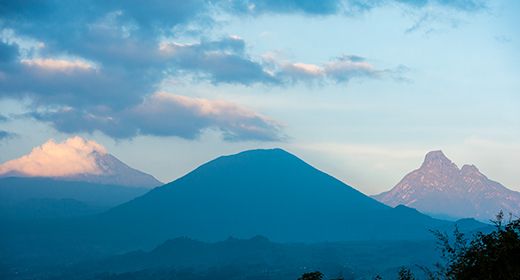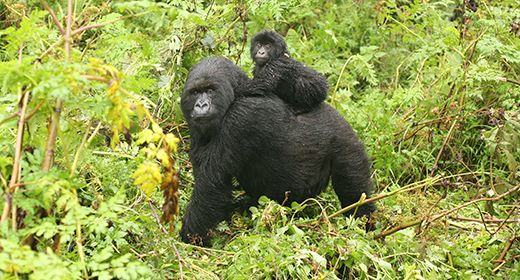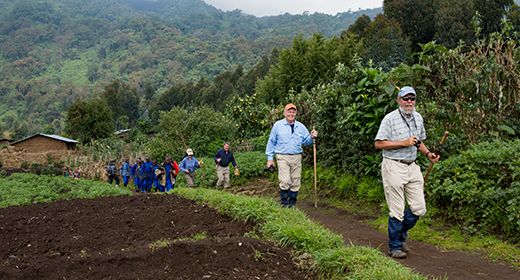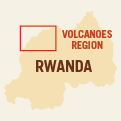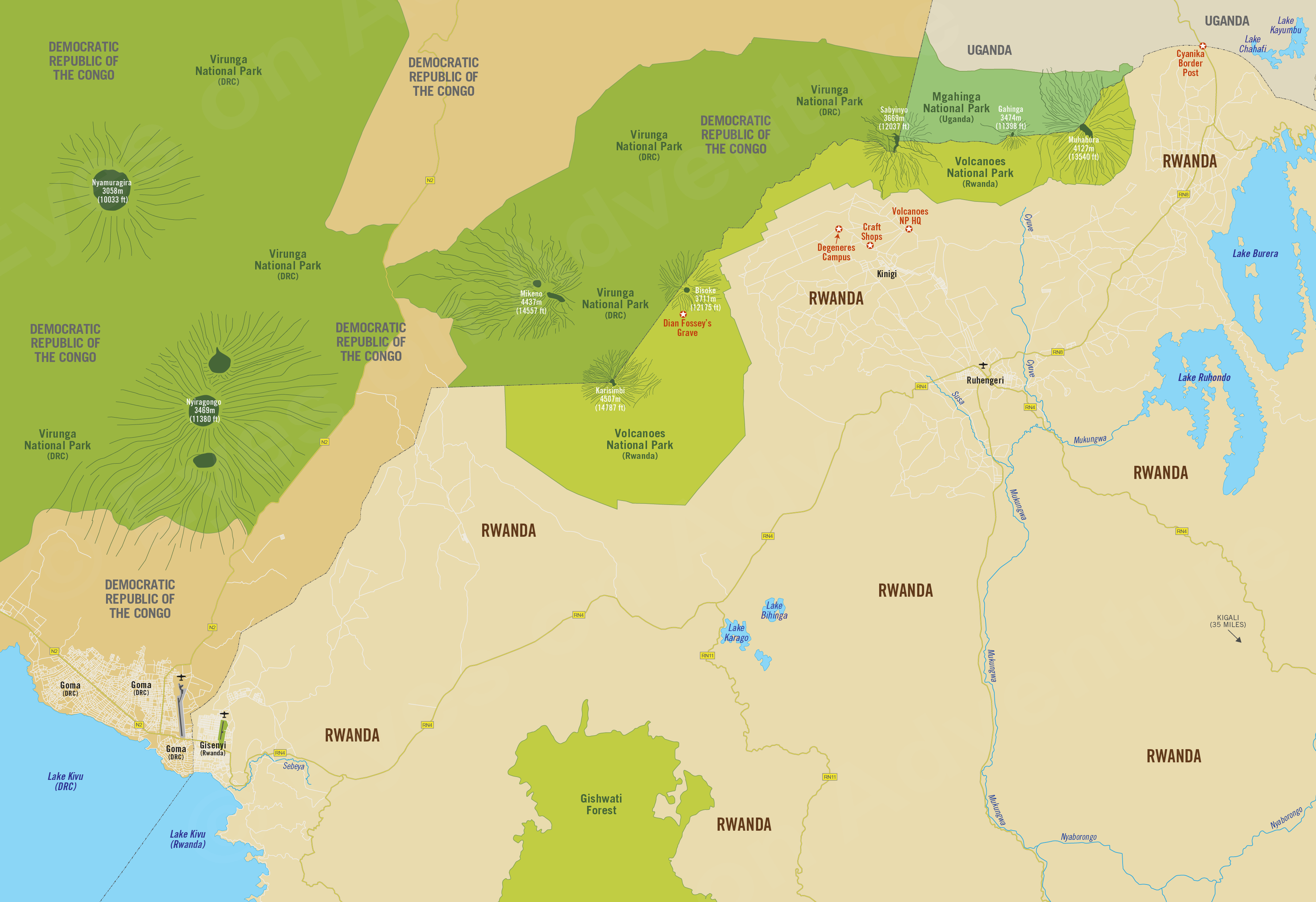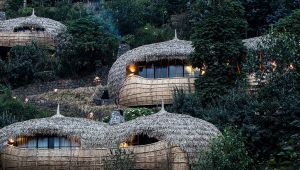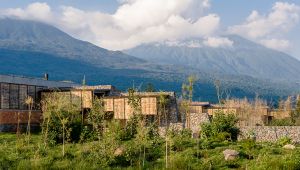Rwanda Volcanoes
Region Links: Rwanda Volcanoes
Highlights
- Mountain gorilla treks offer an incredible experience
- 10+ habituated gorilla groups with 100% trek success
- Golden monkey trekking
- Other hikes: mountain summits, Dian Fossey's grave
- Friendly locals and spectacular scenery
EOA Recommends: Bisate Lodge, Five Volcanoes Boutique Hotel, Sabyinyo Silverback Lodge, Virunga Lodge
Rwanda's volcanoes region is the country's most popular destination, known for offering guided hikes to see the endangered mountain gorillas that live on the forested slopes of its mountains.
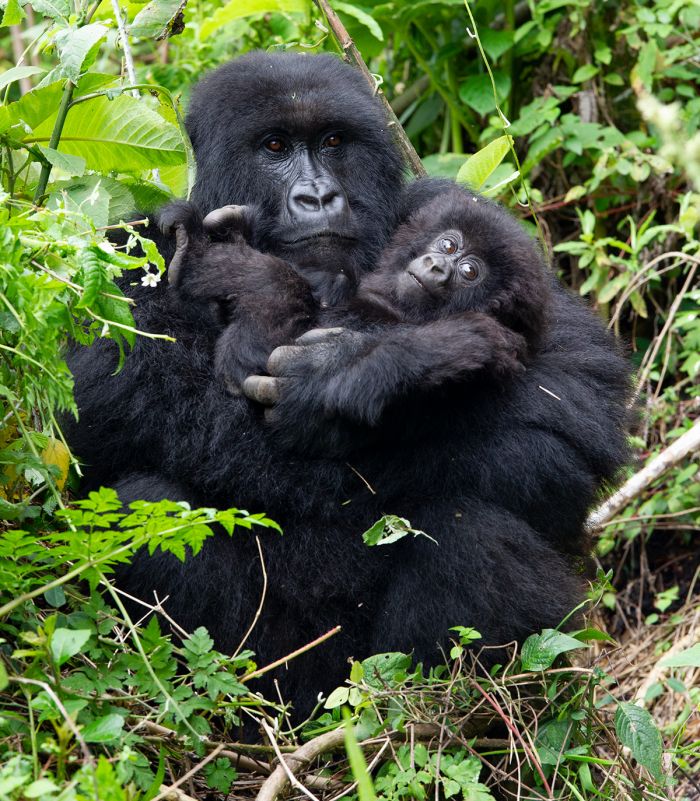
A mountain gorilla cuddles her baby (Copyright © James Weis)
Volcanoes National Park, also referred to by its French name, Parc National des Volcans, is the Rwandan section of the Virunga Mountains, a chain of eight volcanoes that straddle the borders of Rwanda, Uganda, and the Democratic Republic of the Congo (DRC).
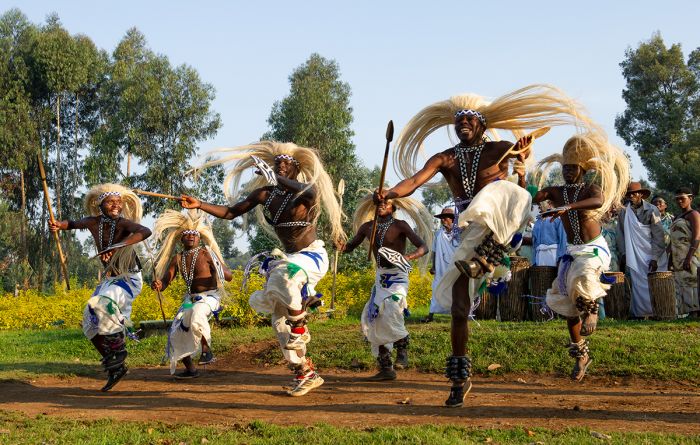
Traditional dancers perform at Volcanoes Park HQ (Copyright © James Weis)
The mountain gorillas of the Virungas gained worldwide attention after the release of the 1988 film, Gorillas in the Mist, which chronicles Dian Fossey's 18-year study and work to protect these critically endangered animals.
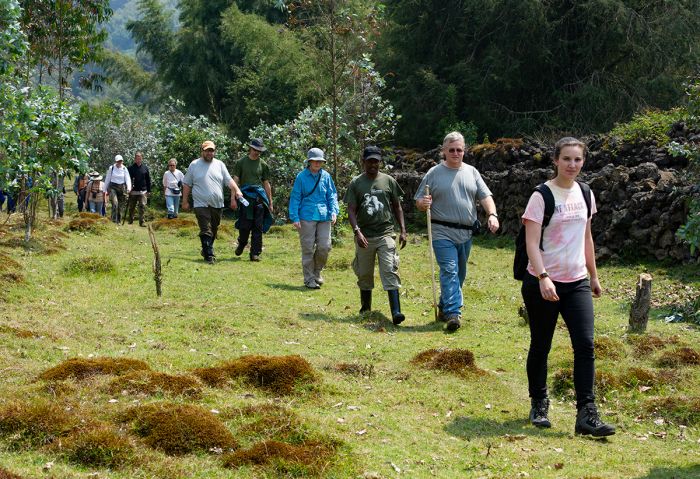
Gorilla trekkers walking along the park boundary wall (Copyright © James Weis)
Today, a guided hike to see the gorillas is widely considered to be one of the greatest animal interaction activities available in the world. Each day, eight tourist are led on a 'trek' to locate and spend one hour with one of the 10 or more "habituated" gorilla families living on the Rwandan slopes of the volcanoes.
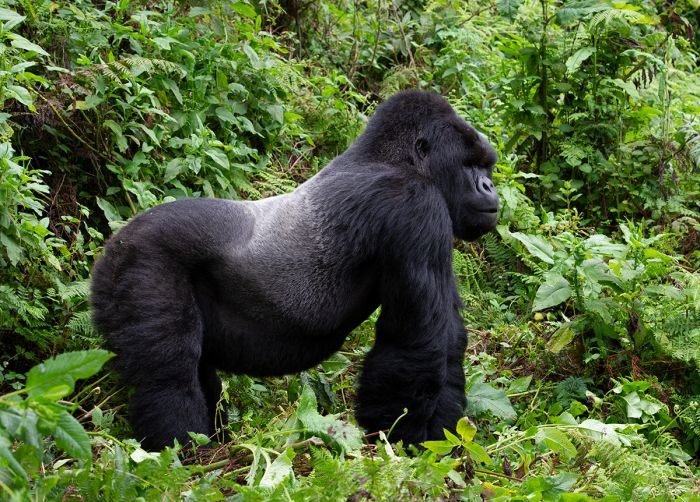
An impressive silverback strikes a pose (Copyright © James Weis)
Visiting the gorillas requires a permit and they are not inexpensive, but the proceeds go towards protecting the gorillas and the gorilla tourism project has been a huge success. Gorilla trekking has become so popular that the limited number of daily permits are often booked out many months in advance. Seeing the gorillas is a virtual guarantee, as the families' whereabouts are closely monitored.
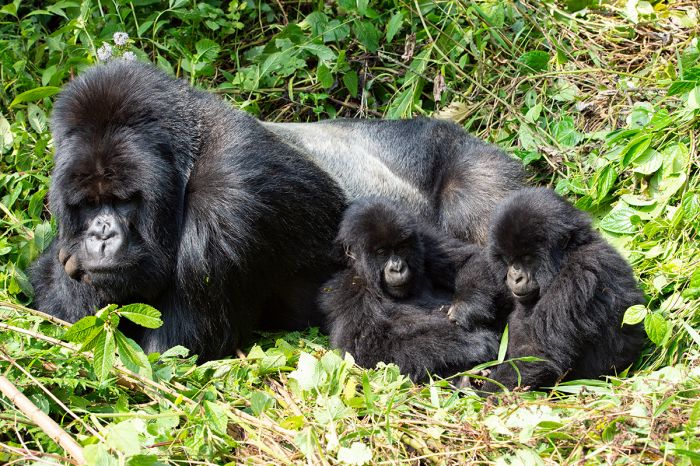
A silverback with two of his young (Copyright © James Weis)
Besides gorilla trekking, visitors can also visit the region's other rare primate, the golden monkey, an endemic and endangered primate. Other wildlife in the national park includes bushbuck, buffalo, duiker, and elephant, although these animals are shy and rarely encountered.
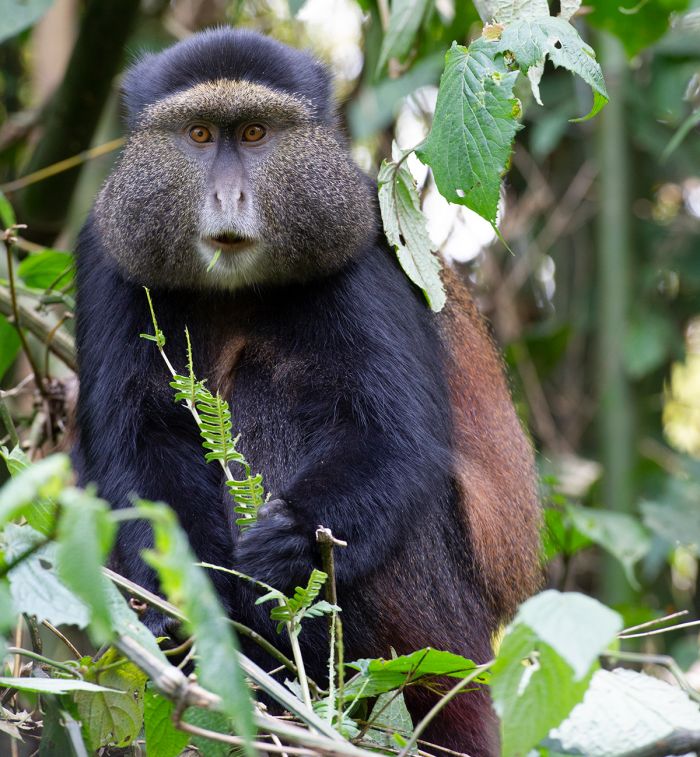
The golden monkeys are another Virunga special (Copyright © James Weis)
Most visitors to the region stay in one of the lodges close to the National Park Headquarters in Kinigi, where gorilla trekking groups are assigned each morning. Lake Kivu and Lake Burera each offer accommodation options further afield that are worth consideration.
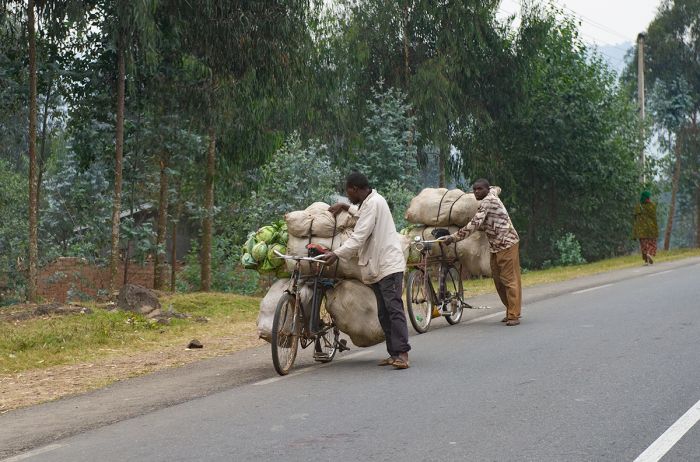
Locals moving produce from their farms in Kinigi (Copyright © James Weis)
Read More...
Mountain Gorillas: Activity, Diet, Discovery, Gorilla Conservation, Gorilla Research, Gorilla Tourism, Habitat, Physicality, Reproduction, Society, Taxonomy
Gorilla Trekking: Background, Clothing & Gear, Permits & Pre-Trek, Time with Gorillas, Tipping, Trekking Details, Trekking Rules, Weather
Geography/History: Dian Fossey, Golden Monkeys, History, Kwita Izina, National Parks, Other Hikes, Virunga Mountains, Where to Base, Wildlife
Mountain Gorillas
Discovery
Gorillas were first discovered by Thomas Staughton Savage, an American Protestant clergyman, missionary, physician and naturalist. In 1836, Savage traveled to Liberia as a missionary and during his stay, he acquired the skull and bones of a heretofore unknown ape species. In 1847, along with American anatomist and naturalist Jeffries Wyman, he described the ape as Troglodytes gorilla. These gorilla bones were those of the western lowland gorilla (see below).
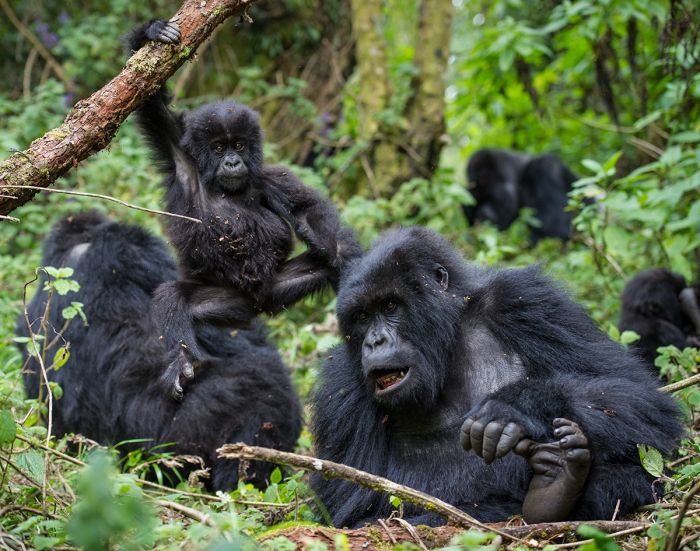
Gorilla trekking in Rwanda is a special adventure (Copyright © James Weis)
The first European to discover a mountain gorilla in the wild was the German army officer and explorer Friedrich Robert von Beringe. In 1902, Captain von Berenge led an expedition for the Schutztruppe, the protective force of German East Africa (which was a German colony consisting of present-day Burundi, Rwanda, and mainland Tanzania), to visit German outposts and visit local tribal chiefs to confirm and ensure good relations.
Setting out from Usumbura (a Burundi port on Lake Tanganyika), von Beringe's team headed for the Virunga Mountains and made the first known attempt by a European to climb Mount Sabyinyo.
A report of the expedition is included in the 1910 book "In the Heart of Africa" by The Duke Adolphus Frederick of Mecklenburg:
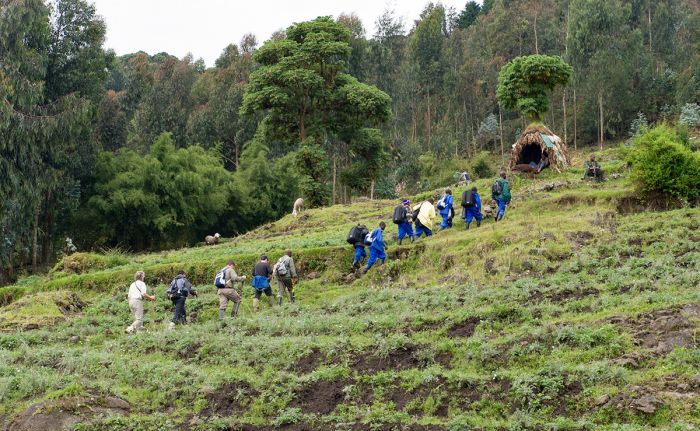
A gorilla trekking group ascend through cultivation (Copyright © James Weis)
En route along the upper slopes of the volcano, the team spotted a "herd of big, black monkeys" and shot two of them dead, both of which fell into a deep ravine. After five hours of arduous effort, they were able to retrieve the body of one animal, describing it as "a big, human-like monkey of one and a half metres in height and a weight of more than 200 pounds. His chest had no hair, and his hands and feet were of enormous size."
The remains of the animal were shipped back to Germany, where it was classified as a new species and given the scientific name Gorilla beringei, in honor of Captain Beringe.
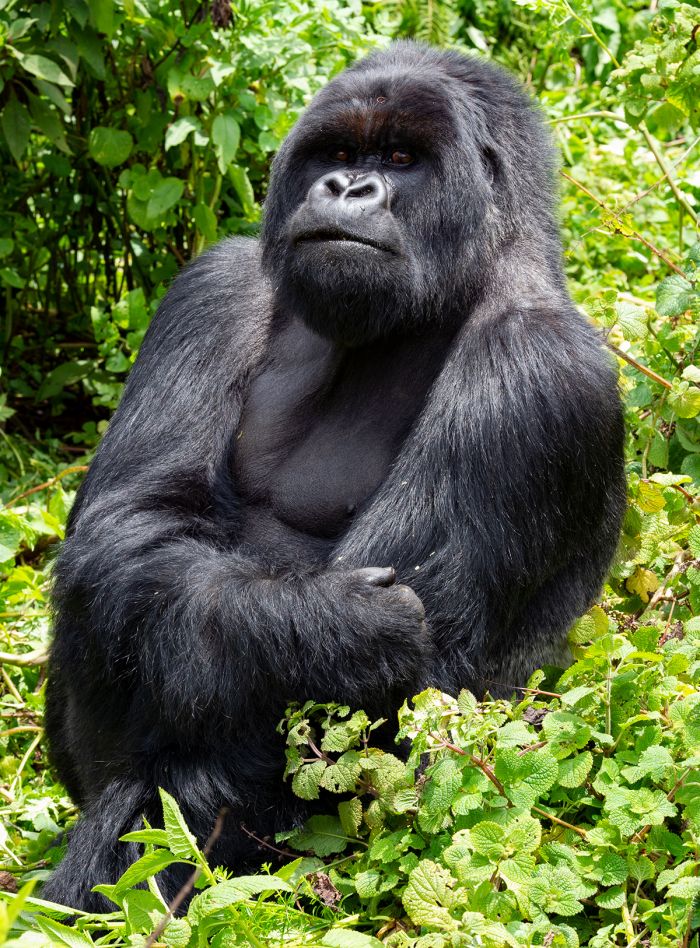
A very impressive silverback (Copyright © James Weis)
Gorilla Taxonomy
Gorillas belong to the taxonomic family Hominidae, which is also known as the great apes or hominids. The family consists of four extant genera: Pongo (orangutans), Gorilla, Pan (chimpanzees and bonobos), and Homo (humans).
Between 12 and 18 million years ago, the Hominidae family split into two subfamilies: Homininae (humans, chimps, and gorillas) and Ponginae (orangutans). The divergence of Homininae into its separate tribes of Gorillini (gorillas) and Hominini (humans and chimpanzees/bonobos) occurred between 8 and 10 million years ago. Humans and chimps separated into distinct species some 6-8 million years ago.
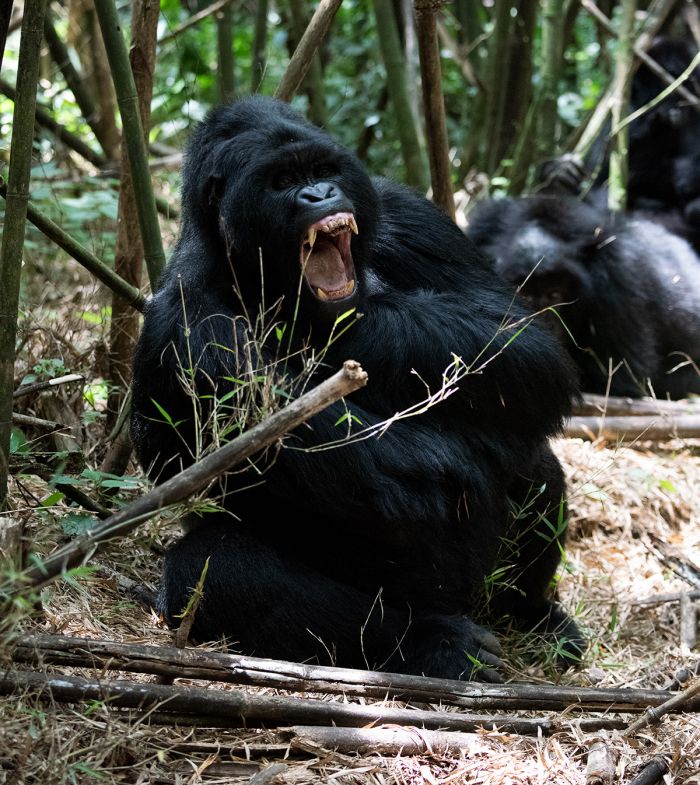
An impressive blackback coming into his prime (Copyright © James Weis)
Since their discovery, there has been considerable debate over the proper scientific classification of gorillas. The genus was originally classified as Troglodytes in 1847, but renamed to Gorilla in 1852.
Since 1967, all gorillas have been recognized as one species (Gorilla gorilla), with four subspecies: G.g. gorilla (western lowland gorilla, living in the lowland forests of central and west Africa), G.g. beringei (mountain gorilla, living in the Virunga Mountains and Bwindi), G.g. graueri (eastern lowland gorilla, living in the lowland forests of eastern DRC), and G.g. diehli (Cross River gorilla, living in a small patch of forested mountains and highlands in Cameroon and Nigeria).
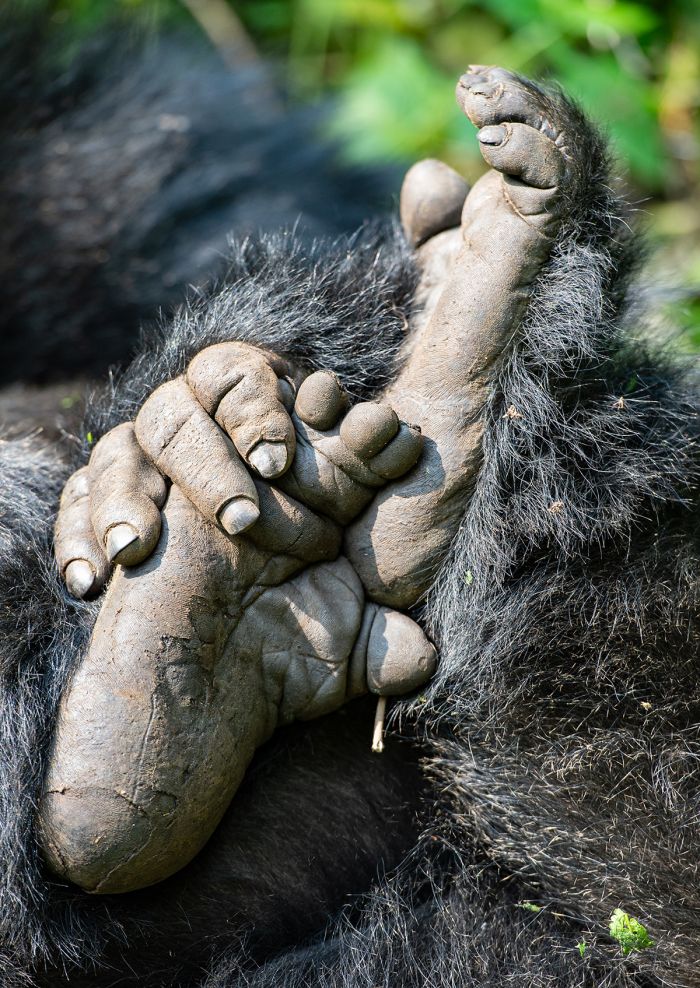
Mountain gorilla hand and feet (Copyright © James Weis)
The extant species and subspecies of gorilla developed from a single type of gorilla that is believed to have once ranged across the vast Congo River basin from the Atlantic coast of Africa to the western Rift Valley of Central Africa.
During dry periods in the last Ice Age, which peaked some 18 000 years ago, the rain forest contracted into fragmented patches, thus isolating populations geographically.
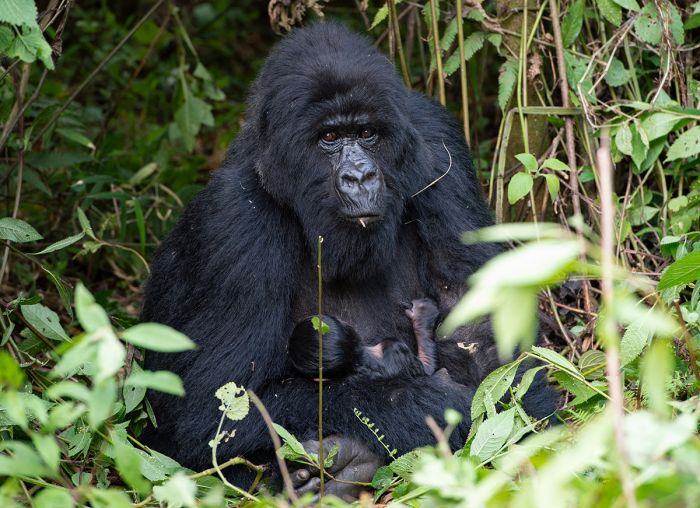
A female nursing her new-born infant (Copyright © James Weis)
There are two distinct populations of the mountain gorilla (Gorilla gorilla beringei), one found in the Virunga Mountains of Rwanda, Uganda, and the DRC, and the other in Uganda's Bwindi Impenetrable National Park. There is discussion amongst some primatologists as to whether the two populations should be separated into two subspecies.
Genetic sequencing of the base building blocks of gene types shared between humans, chimpanzees and gorillas, shows that the genetic differences between individual humans today is a minuscule 0.1%, while differences between human and chimpanzee genomes average about 1.2%, making chimps our closest living relative on an evolutionary basis. Humans and gorillas differ by around 1.6% and humans and orangutans by 3.1%.
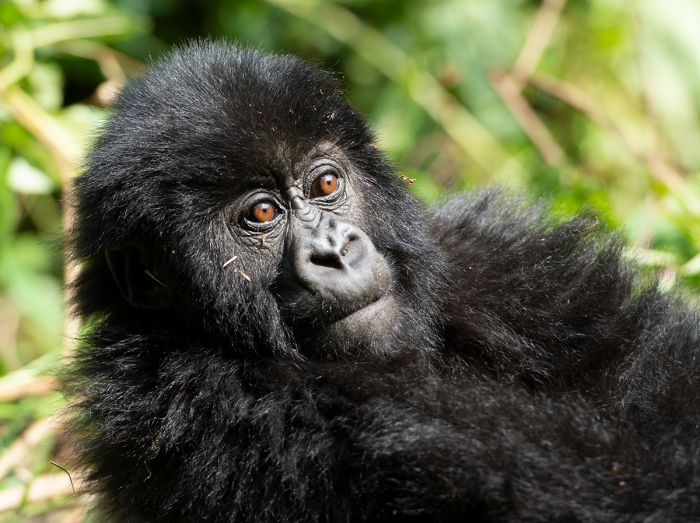
A young mountain gorilla (Copyright © James Weis)
Physical Characteristics
Mountain gorillas are sexually dimorphic, with adult males being roughly twice the size of adult females. Adult males weight between 330-420 pounds (150-190 kgs) and have an upright standing height of 55-63 inches (140-160 kms). Females average 220 pounds (100 kgs), with a height of 51 inches (130 cms).
Mountain gorillas have a thick, black fur, with some animals exhibiting some brownish coloration on their heads. Adult males are referred to as "silverbacks", due to the saddle of grey or silver-colored hair that develops on their backs when they become mature.
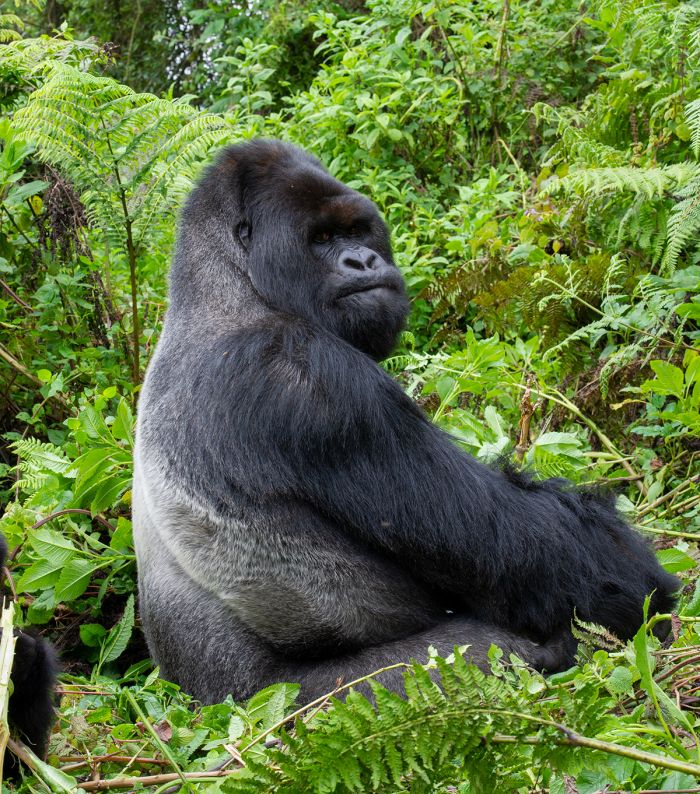
Mature males are often called "silverbacks" (Copyright © James Weis)
Habitat
Mountain gorillas exist as two distinct populations, one in the Virunga Mountains and the other in Uganda's Bwindi Forest. Each of the mountain gorilla populations number about 550 individuals, making for a total population of around 1 100 mountain gorillas. Although only 31 miles (50 kms) separate the edges of the two ranges, the forest that once connected them has long been removed by humans, primarily for agriculture.
Both populations spend most of their time in montane forests, with those in the Virungas ranging in elevation from 7 200-14 100 feet (2 200-4 300 meters), while the Bwindi population lives at elevations between 3,900-8,550 feet (1 190-2 600 meters).
These forests are characterized by dense vegetation at the lower elevations, becoming morse sparse at the higher elevations. The atmosphere is lush and often misty or covered by clouds that reach the ground level.
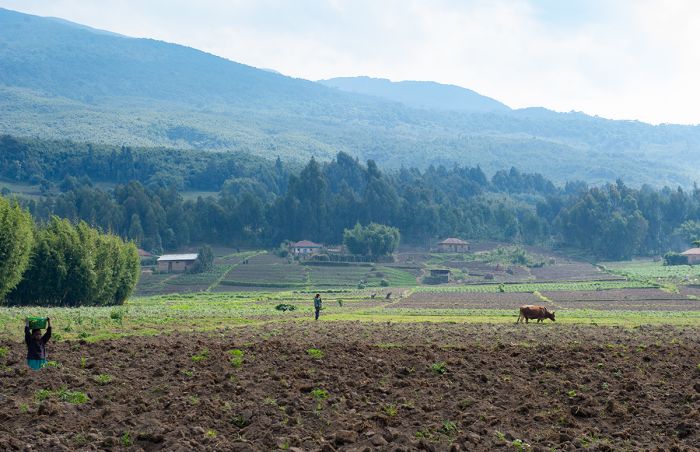
Lower elevations of the original forest are now farmland (Copyright © James Weis)
The gorillas have a home range that is determined by the availability of their preferred food sources and includes multiple vegetation zones. The key zones include bamboo forest at 7 200-9 200 feet (2 200-2 800 meters), Hagenia forest at 9 200-11 200 feet (2 800-3 400 meters), and afro-alpine meadow at 11 200-14 100 feet (3 400-4 300 meters).
The size of a group's home range varies between 1.5-3 square miles (4-8 sq kms), but they range much further to access favored food sources during specific periods of the year when those items are available in abundance.
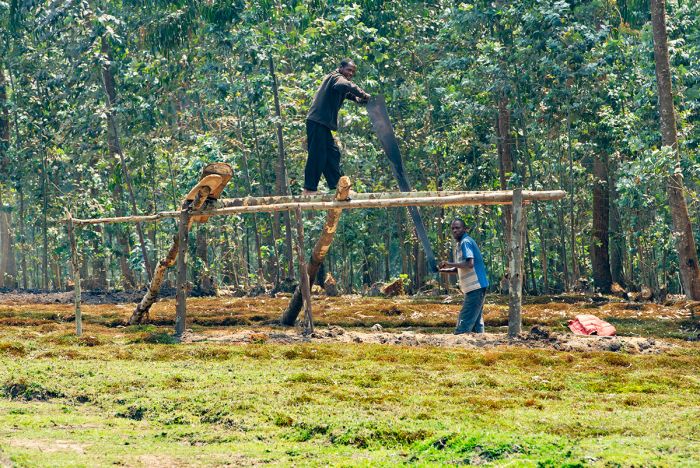
Eucalyptus, a non-native species, is widely cultivated (Copyright © James Weis)
Social Structure
Like all sub-species of gorilla, mountain gorillas are highly social, living in cohesive groups that vary in number from five to thirty, but averaging ten to fifteen individuals. A typical group has a dominant male (silverback), one or more subordinate silverbacks (usually a relative of the dominant silverback), one or two blackbacks (males that have not yet reached their prime), three to five sexually mature females (usually bonded to the dominant silverback for life), and three to seven juveniles and babies.
The dominant silverback dictates most of the group's movements, including feeding sites and overnight sleeping locations. He also mediates all disputes within the group and defends the others from any external threat. During periods of relaxation during the day, he is the center of attention, especially for the young gorillas, who often stay close to him and even include him in their playful games.
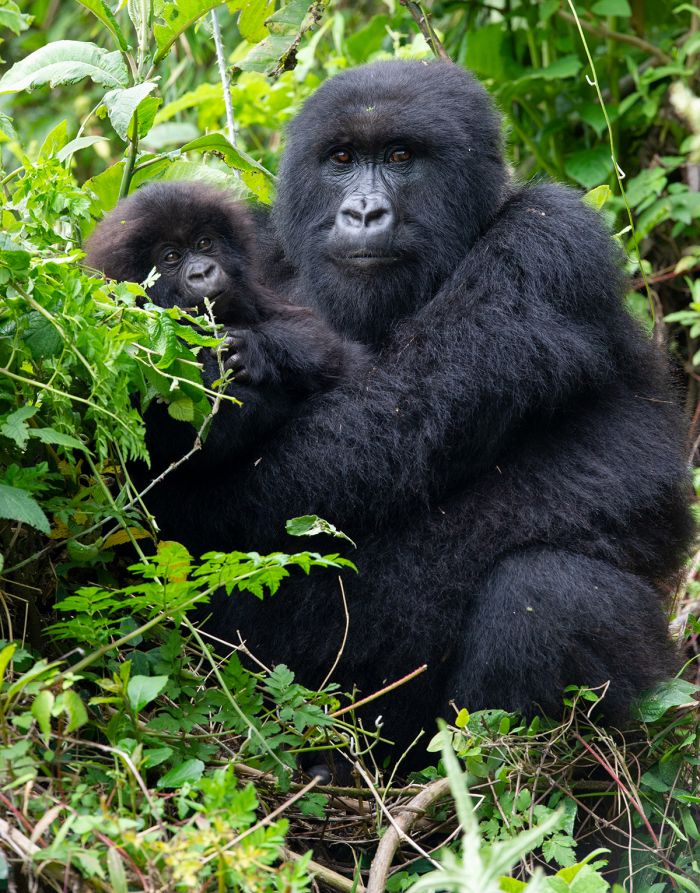
Mountain gorillas are highly social animals (Copyright © James Weis)
Most gorillas, both male and female, emigrate from their natal group when they are subadults and join other gorilla groups. Males typically leave beginning around 11 years of age, while females depart when they are around 8 years old. Occasionally, a male may remain in his father's group if the patriarch is of advanced age and there is a chance of him inheriting the group, but this is rare and the younger male will typically be overthrown and ousted by an older, more experienced male from outside the group.
Emigrating females are almost always immediately welcomed by either an already established group or a lone male. Females often join a succession of groups or lone males before settling on a permanent group. Emigrating males typically travel alone or with an all-male group for two to five years, gaining size and strength, before they are able to attract females to join them and form their own group or attempting a takeover of an existing group.
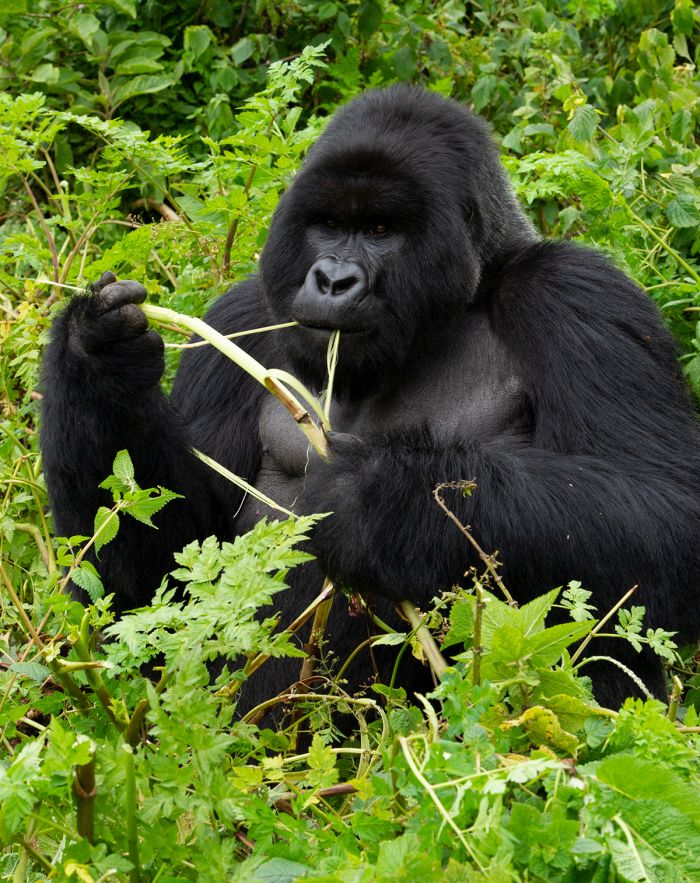
The dominant silverback enjoying "wild celery" (Copyright © James Weis)
Diet
Mountain gorillas are almost exclusively herbivorous, with a diverse diet comprised of over 100 plant species. Leaves, stems, and shoots account for the majority of their food, with the remainder being roots, bark, snails, grubs, insects, and fruits. The slopes of their Virunga Mountains habitat include various vegetation zones, and the gorillas will visit each to take advantage of the favorite food items when they are available in abundance.
Favored food items include numerous herbaceous plants, bamboo shoots, various species of stinging nettles, Galium vines, thistles, fruits, and flowers. They spend the majority of their time in the Hagenia abyssinica forests, where the nutritious Galium vines are found all year. The bamboo forests grow at the lower elevations of the protected area and the gorillas visit these forests during the few months each year when fresh shoots are available.
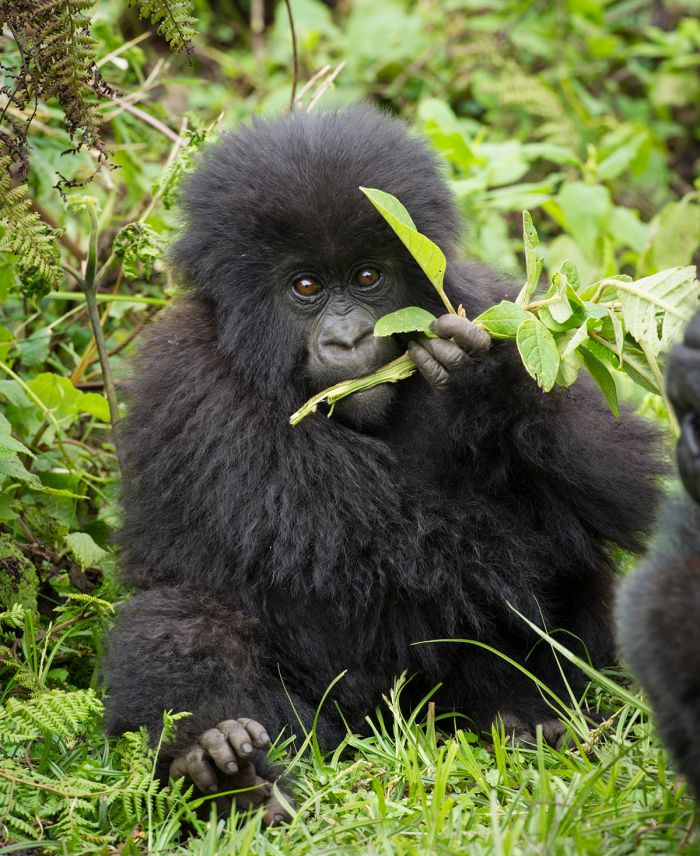
Young gorillas learn early which foods to eat (Copyright © James Weis)
Adult males eat up to 75 pounds (34 kgs) of vegetation per day, while adult females consume about 40 pounds (18 kgs). Their vegetation-based diet means that the gorillas' stomachs are often bloated and they are renowned for their flatulence. Because their diet is rich in succulent herbaceous plants, mountain gorillas rarely need to drink water.
Mountain gorillas almost never compete over specific food items, nor do they share food. Whenever access to a food source is limited, the dominant silverback will monopolize the best position. Under normal circumstances, the group is well spaced out while foraging, as most food items are present in abundance over a good sized area.
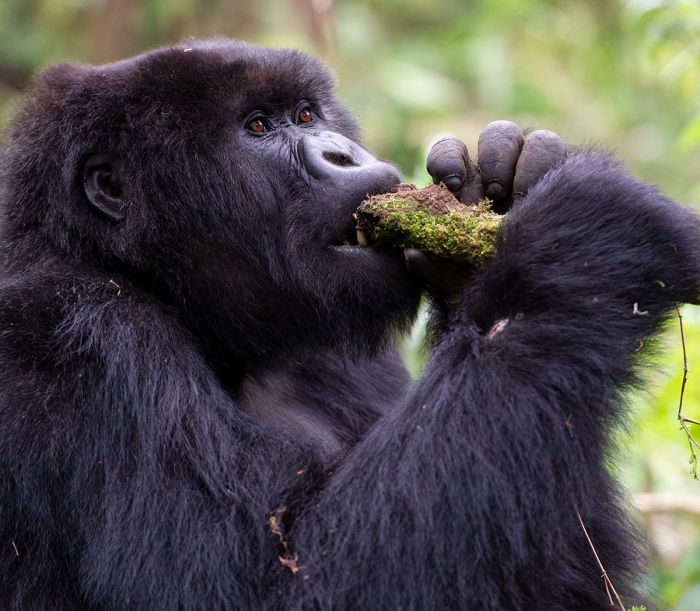
A gorilla eating moss (Copyright © James Weis)
Activity
Mountain gorillas spend roughly 30% of their waking hours feeding, another 30% traveling or traveling while feeding along the way, and 40% resting (or playing for the young ones). All members engage in the same behavior as a group and the peak activity in terms of moving and feeding occur during the first 4 hours of the day. The midday is typically spent as an extended rest, followed by another feeding session beginning mid-afternoon.
Mountain gorillas retire for sleep during the last hour of light and awaken during the first hour of light. During cold mornings, they will spend more time basking in the sun and during rain they may huddle together.
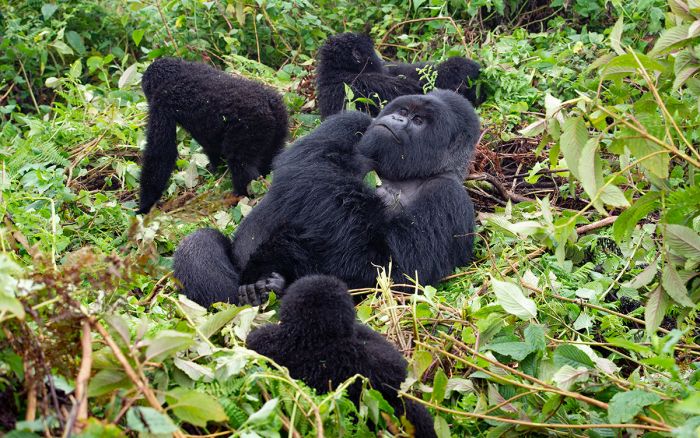
The silverback during the mid-day rest period (Copyright © James Weis)
Mountain gorillas build nests each night for sleeping. Nests are made from branches, vines, and other soft vegetation, which are piled together to to create a bed for the night. Building a nest typically takes about five minutes. Most nests are made on the ground, but some smaller gorillas may also sleep in a tree on some nights. Infants sleep in their mother's nest until around age 3 or until another sibling is born.
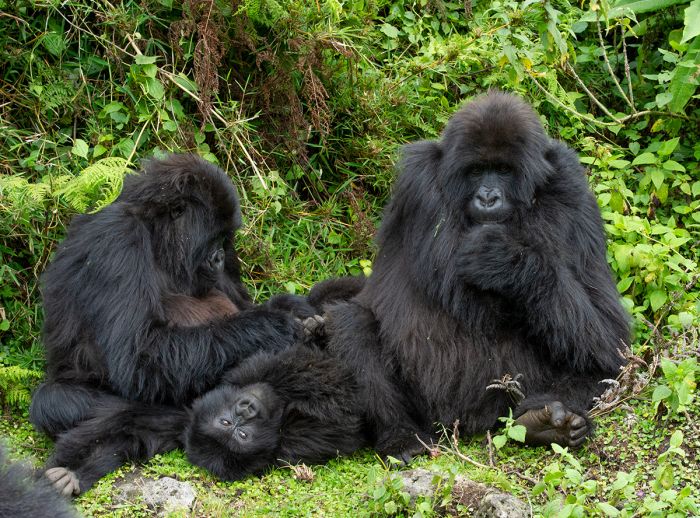
Grooming time (Copyright © James Weis)
Reproduction
Similar to the other great apes, gorillas reproduce at a very slow rate, with an average of 4-5 years between births, unless an infant dies, in which case the mother will become sexually receptive again within a year.
During a female's 40-50 year lifespan, she may have up to six young. Females become sexually mature at around seven years and mature males are sterile until around 11-13 years of age. The gestation period for mountain gorillas is around 8.5 months.
A female's estrus lasts 1-2 days and during that time, mating occurs roughly every hour (during daylight hours). It is not uncommon for more than one mature female in a given group too be in estrus simultaneously, making for busy days for the silverback.
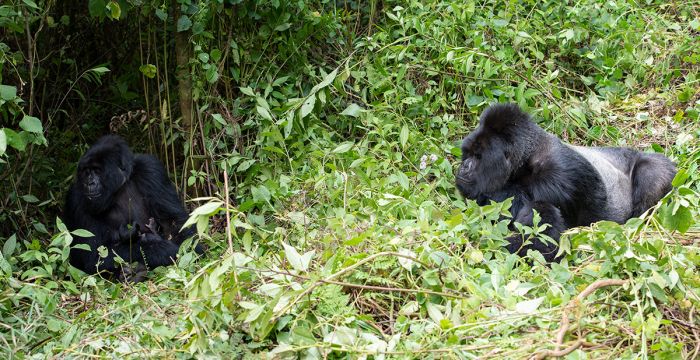
The silverback has a look at his newest offspring (Copyright © James Weis)
Most copulation is initiated by the female and almost always involves only the dominant silverback. Both the male and female vocalize during copulation. These vocalizations often attracts the attention of other gorillas in the vicinity, including other lone silverbacks or males from other established groups.
It is during these situations that females may emigrate to a different group or join a lone male. The presence of other silverbacks can also lead to aggression and fights between the males.
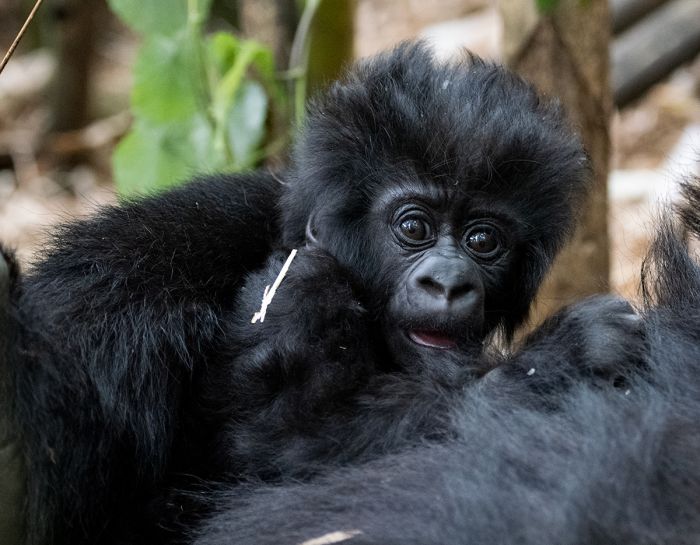
Females may give birth every 4-5 years (Copyright © James Weis)
Gorilla Trekking
Background
Taking part in a guided hike in the lush forests of the Virunga Mountains to see a group of "habituated" mountain gorillas is surely one of Africa's greatest wildlife adventures. If you aren't sure, just ask anyone who has done this and they will confirm how amazing it is!
As described further above, mountain gorillas live in groups of between 5 and 30 individuals, (the average group size is 10 to 15) and there are many such groups living throughout the volcanic slopes of the Virunga Mountains in Rwanda, Uganda, and the DRC. On the Rwandan side, there are 10 gorilla groups that have been habituated to seeing humans on a daily basis and they are part of the gorilla trekking activity in Volcanoes National Park.
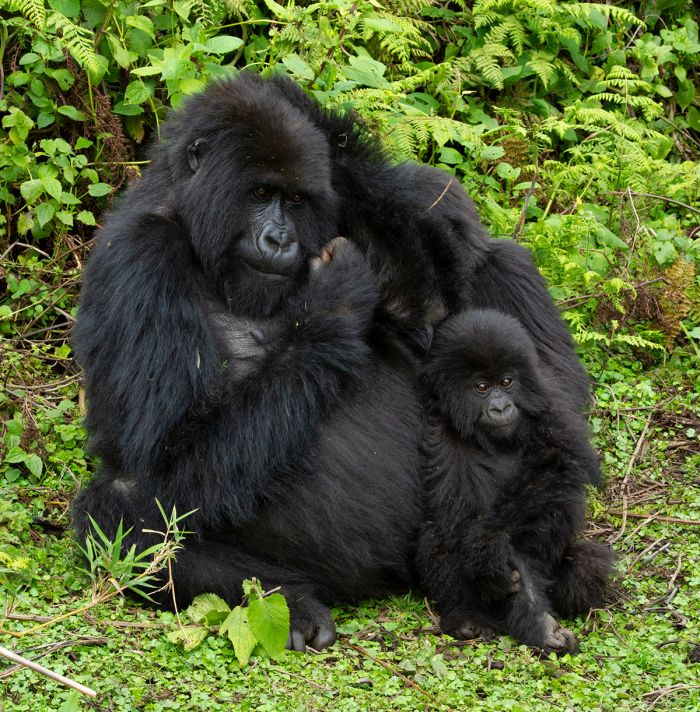
Up close viewing of gorillas in Rwanda (Copyright © James Weis)
The habituation process involves a long and careful process whereby park guides gradually get the gorillas comfortable with human presence for a limited time every day. The process can take many months, during which time a trust is built up between the guides and the gorillas. The guides imitate gorilla vocalizations to show deference to the silverback and you may notice your guide doing this during one of your treks.
Each habituated gorilla group is visited once per day, for one hour of interaction, by a group of eight tourists, along with their trekking guides, trackers, and porters (who will carry your gear for a small tip).
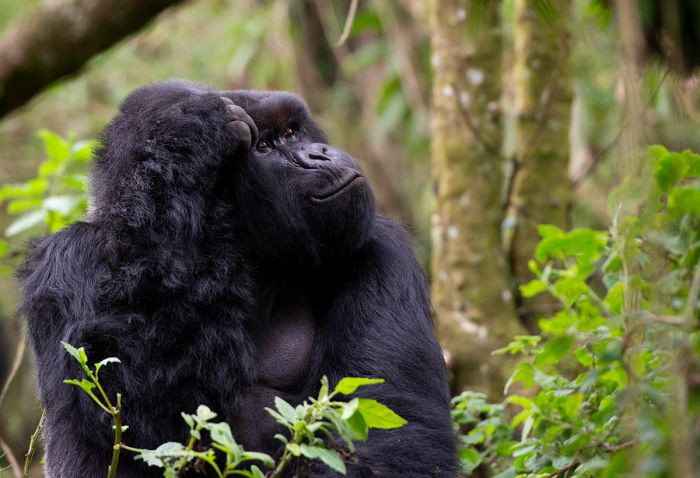
Spending time with the gorillas is a unique experience (Copyright © James Weis)
Permits and Pre-Trek Details
In order to reserve a position for gorilla trekking, a gorilla permit is required. The permits are only available directly from Volcanoes National Park (operators and travel agents can also sell them) and are sold only to a specific person (transfers are not permitted) for a specific day. Each morning at 7am, all permit holders meet to check in at the Volcanoes NP Headquarters in Kinigi, where the permits are collected and checked (bring your passport) against purchase records.
It is possible to show up at the Park HQ and purchase a permit, but permits are typically sold out far in advance and typically, your only chance of obtaining a permit is if someone does not show up. In this case, the park officials may resell that permit. This is NOT recommended, as there is little chance of actually getting lucky and finding a permit by just showing up.
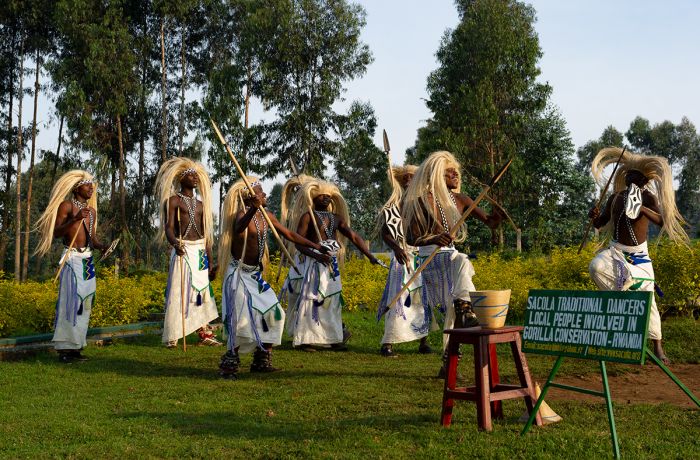
Traditional dancers perform at Park Headquarters (Copyright © James Weis)
Permit cost: The cost for one permit (since 01-June 2012) is USD 750.
While the permits are accounted for the day's trekking and trekking groups organized and allocated to a guide/gorilla group for the day, trekkers can watch traditional dancers put on a 30-minute performance while enjoying a cup of complimentary coffee or tea. Flush toilets are also available.
Trekking conditions differ greatly according to the specific location of the gorilla groups, so the exact level of difficulty for a specific trek is impossible to define in advance. However, at the time of assignment to a gorilla group at the Park HQ, you are able to request an "easy" trek or a "more challenging" trek, so if you are not sure of your fitness level, make sure to get onto a shorter trek.
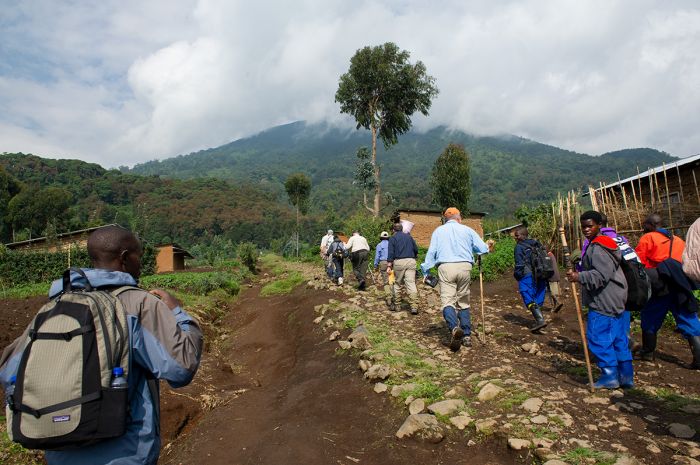
Trekkers ascend through farmland below the mountains (Copyright © James Weis)
It is recommended that you prepare physically by exercising for at least a month prior to your trip. Building up your endurance and leg muscles will be helpful for the actual climbing in the mountains. Exercises such as stair climbing, deep knee bends, and cardiovascular activities like running or cycling are a good idea.
Keep in mind that regardless of your fitness level, you will start trekking from an altitude of at least 8 000 feet 2 450 (meters) and the ensuing climb may ascend to 10 500 feet (3 200 meters) or more, so altitude will certainly be a factor. The guides are very good at pacing the group to allow for the slowest trekker and making sure everyone is able to make the climb without over-exertion.
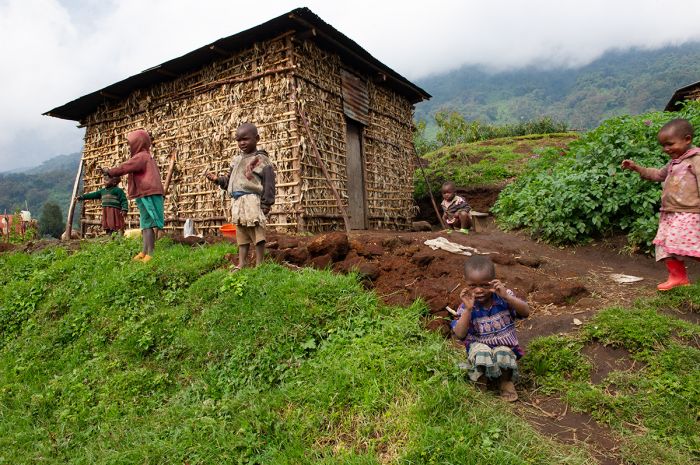
Rwandan children seen on a gorilla trek (Copyright © James Weis)
Trekking Details
Once all permit holders are accounted for, trekkers are assigned to a guide, who will brief his or her group of eight trekkers on the gorilla family they will be visiting that day. After answering any initial questions, your group will load into vehicles and head towards the specific starting point for your trek.
Departure from Park HQ is generally around 8:00am, and depending on which mountain and gorilla group you are visiting, the ride to your specific trailhead can take between 10 minutes and an hour. Once off the paved road, the tracks leading to the starting points wind through rural farmland and small villages, and these tracks are extremely bumpy, but the trip is scenic and great for seeing the local people.
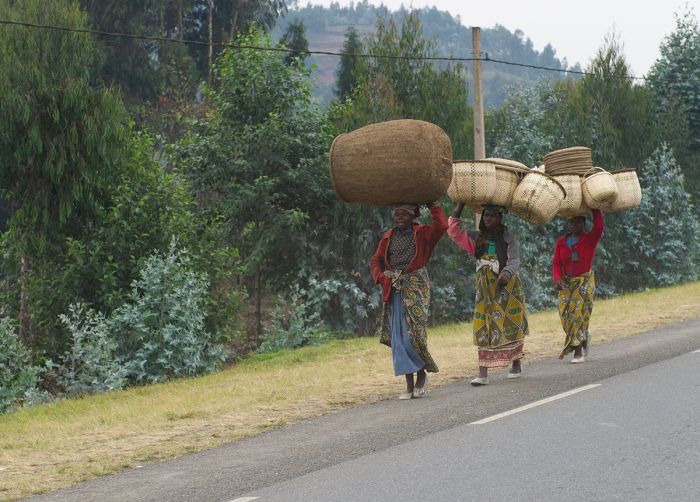
Local women seen en route to the trek trailhead (Copyright © James Weis)
Once at the starting point, everyone will gather their backpacks and cameras and get set to start hiking. A group of porters will meet you here and offer walking sticks and also offer to carry your backpack for you to lighten your load. We strongly advise you hire a porter, as it supports the local community and invests people in tourism and conservation of the gorillas.
Your guide will already be in radio contact with the gorilla trackers, who will be en route to your gorilla group, heading back to the spot where they left them the evening before. Note that gorillas do not move at night, so they are relatively easy to find in the early morning by the experienced trackers. Knowing precisely where the gorillas are in the morning, allows your guide to take the most direct route to them.
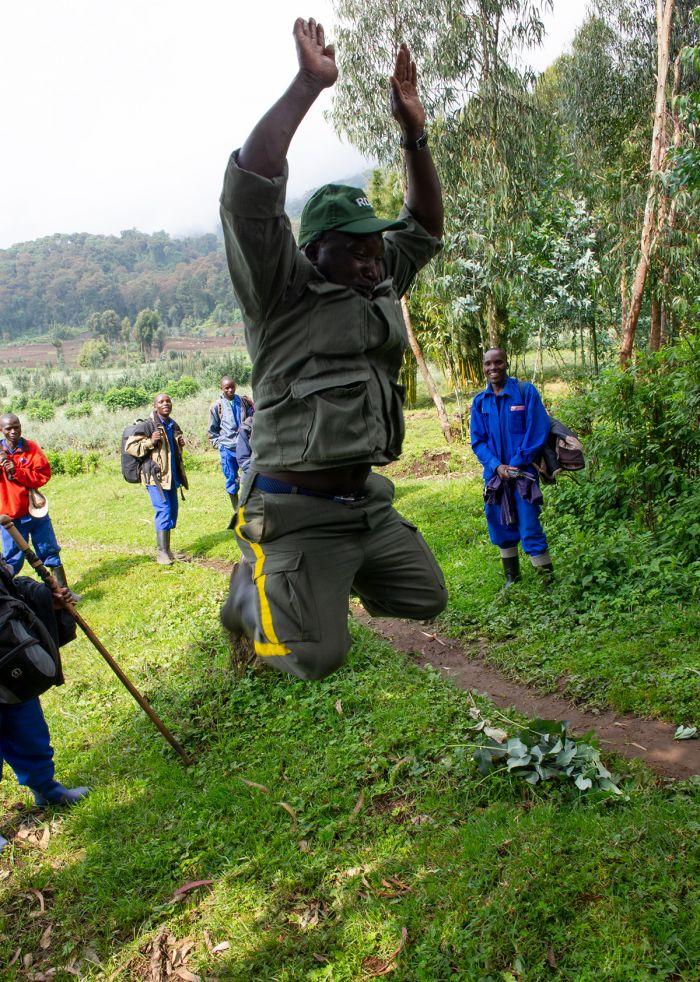
Franciois, a well known guide who worked with Dian Fossey (Copyright © James Weis)
The initial portion of the hike invariably involves walking through cultivated farmland for up to an hour. Fields of potatoes and pyrethrum flowers cover almost every piece of land on the lower slopes of the volcanoes, right up to the stone wall, which demarcates the boundaries of the protected gorilla habitat.
At the edge of the farmland, this low wall covers the many miles of national park boundary. The wall has narrow gaps in certain places, which allow trekkers to squeeze through, although sometimes the group will need to climb over, depending on where the gorillas are located. After a short rest at the wall to drink and eat your packed breakfast or an energy bar, you finally enter the realm of the gorillas!
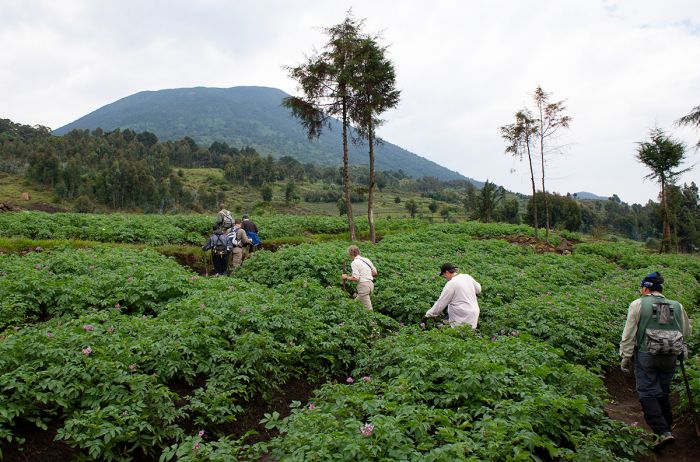
Trekkers ascend through potato fields en route to the gorillas (Copyright © James Weis)
The lower elevations of much of the national park includes Neobutonia (a beautiful flowering plant) forest and then, a bit higher up, the spectacular African alpine bamboo (Yushania alpina) forest. Above the bamboo is Hagenia abyssinica forest, a tree species native to high elevation afromontane regions in Africa. Depending on the time of year and upon which food source the gorillas are concentrating, your trek from the stone wall to the gorillas may last from 10 minutes to several hours.
Regardless of duration, the hiking almost always involves a good amount of physical exertion, steep and sometimes muddy and slippery terrain, and scrambling over, through, and under dense thickets of undergrowth. Some of the vegetation is not friendly to the touch, especially the stinging nettles and various other barbed vines. Proper clothing and footwear are essential for trekking (see suggested clothing section below for details).
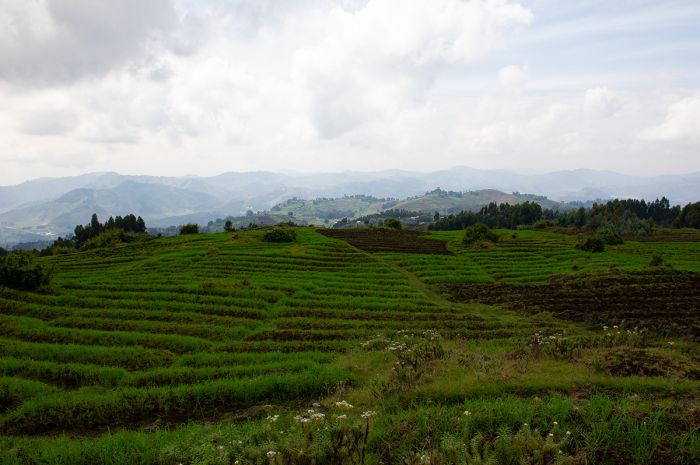
Looking down from the stone wall at the edge of the forest (Copyright © James Weis)
The forested slopes of the volcanoes are steep in places, some more-so than a flight of stairs and also covered in dense vegetation, so being fit will only make your trek more enjoyable. Also bear in mind that climbing at higher altitude means you will have less oxygen than what you are used to.
None of this is meant to dissuade you from this amazing activity and anyone that has a moderate fitness level will be able to make it on any trek. The guides are good at making frequent rest stops along the way so that everyone can catch their breath and have ample time to recover. You will also have a porter to carry your camera/backpack and walking sticks are very helpful, even if you are very fit.
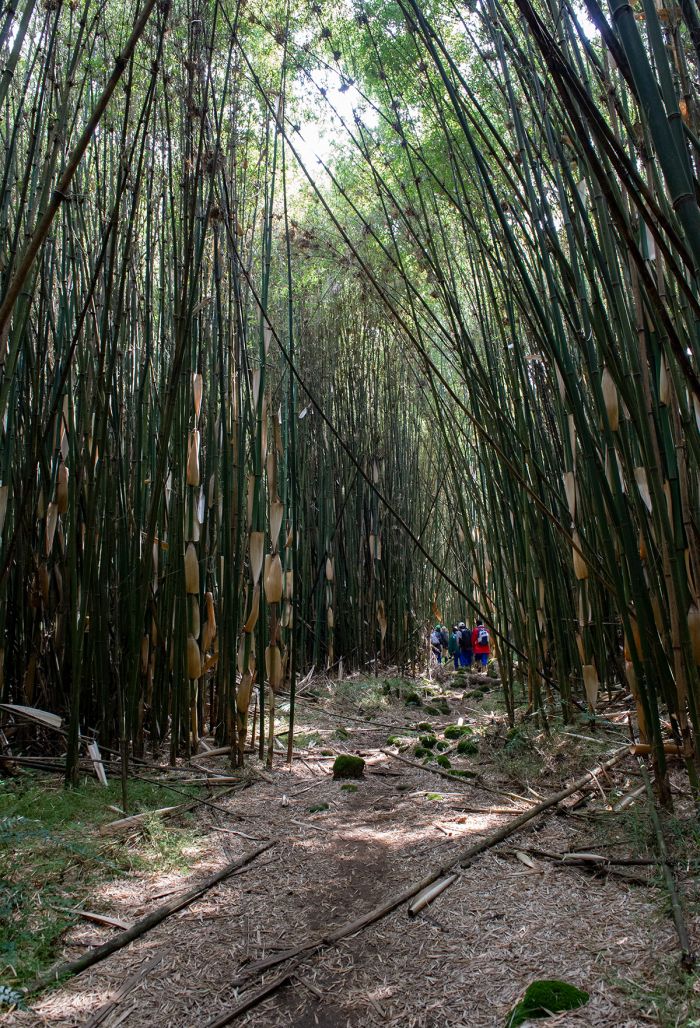
Trekkers climbing in the bamboo forest (Copyright © James Weis)
Time with the Gorillas
Once you reach 'your' group of gorillas, everyone in your trekking group will take a few minutes to catch their breath, have a last drink of water and maybe a quick snack, and prepare cameras. All food, water, and backpacks must be left with the porters at this point and cannot be brought into the sighting with the gorillas.
The guides will again brief you on the rules of conduct when around the gorillas, and instruct everyone to follow quietly behind while he/she leads you to them. You will be allowed one hour with the gorillas, so make sure to remember your camera at this time and take lots of pictures!
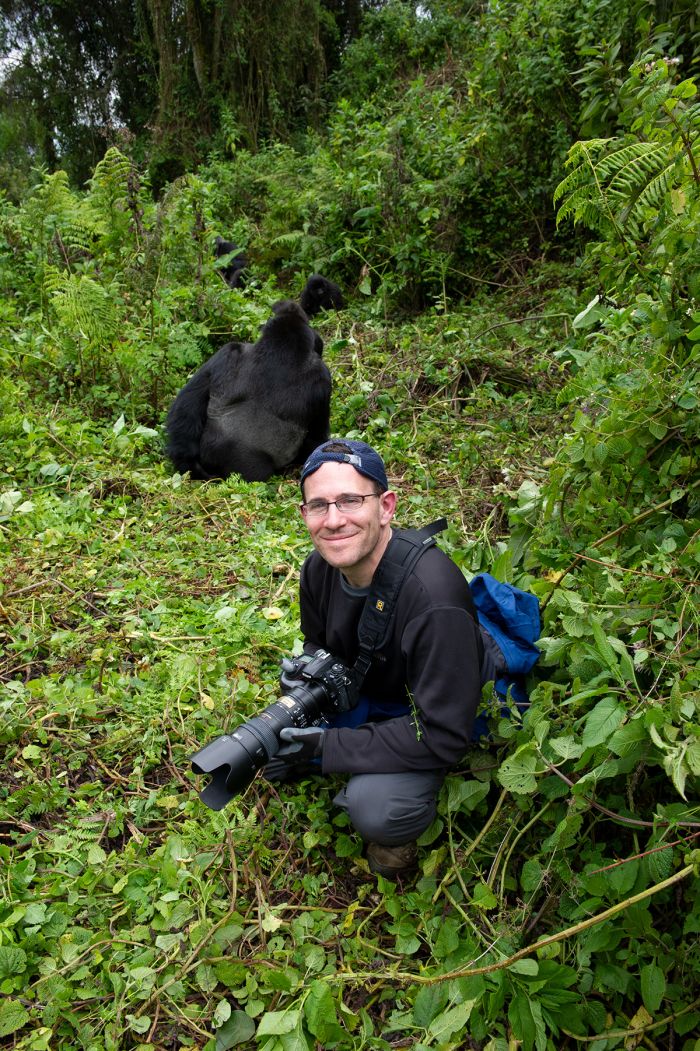
A trekker with the gorillas (Copyright © James Weis)
As you enter the sighting, your guide will alert the gorillas that humans are approaching by making various gorilla-like vocalizations, including low grunts, lip smacking, and groans. These sounds are calming to the gorillas and tells them you are friendly. Although gorillas are mostly very quiet animals and do not often vocalize, these sounds of reassurance are ones that family members use with one another. Most of the gorillas will also be familiar with your guide, as they will have seen him or her many times.
If your ascent to the gorillas has not been a long one, you may be fortunate to visit them during their regular midday rest and play session. During this time of day, the dominant silverback typically lounges on the ground while all the youngsters play around him, roll and wrestle with each other in the vegetation, or climb and hang from trees or vines.
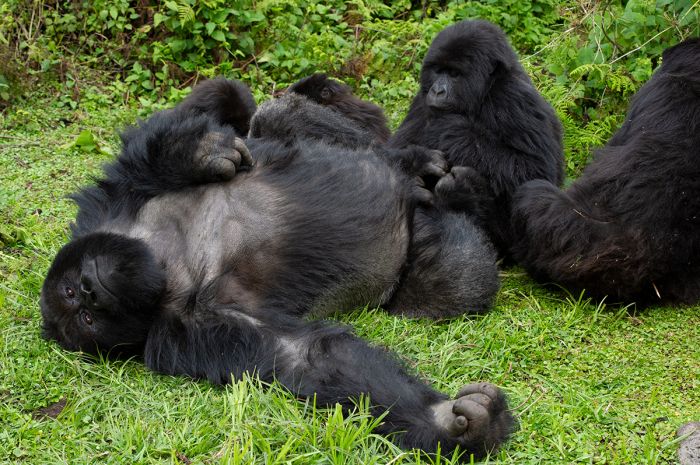
Mid-day relaxation for the gorillas (Copyright © James Weis)
During the mid-day rest time, females will nurse their babies and engage in some play with the young. It is possible that a curious adolescent gorilla may approach you, but although they are adorable and you may be tempted to engage them or touch them, this is strictly forbidden.
The one-hour time limit with the gorillas is carefully observed by the guides in order to protect the gorillas from stress and limit their exposure to humans, who can pass viruses to gorillas. During your interaction, your guide will make efforts to get everyone into good positions by quietly moving the group around to see the different gorillas. Watching the guide and following him or her is a good way to get good photos of the gorillas. The hour passes quickly, so take full advantage and enjoy the experience.
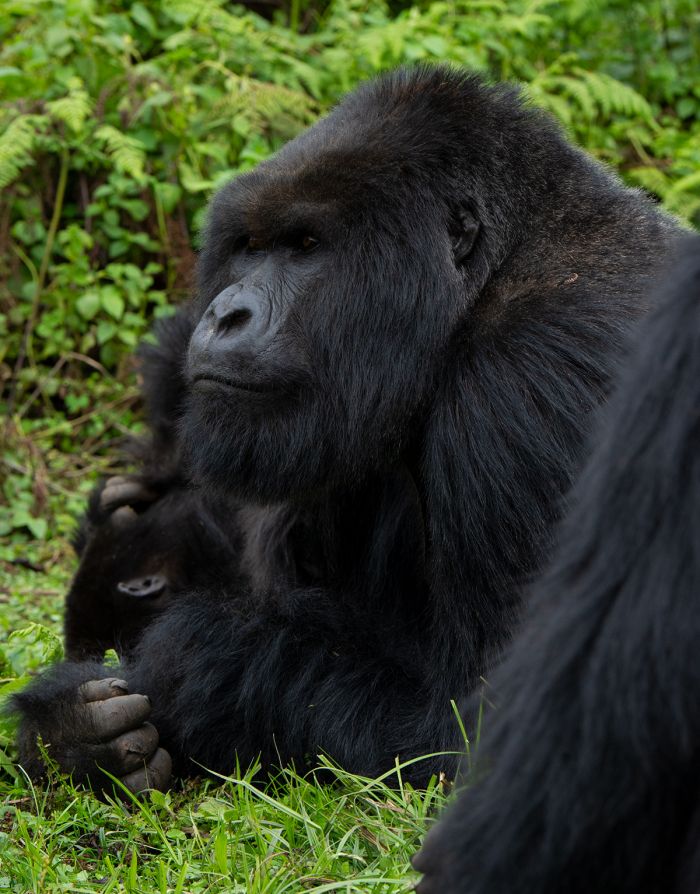
The dominant silverback in repose (Copyright © James Weis)
Once the one-hour visitation time has concluded, the guide will instruct everyone to follow him/her back to the porters and your backpacks, where everyone will let the adrenaline and excitement flush through them and share smiles and discussion. At this point, the early-morning trackers (who left before dawn to locate the gorilla group) will leave to follow the gorillas through the remainder of the day, so they will know where to go for the next day's trek. Please tip them at this time.
Depending on the time of day following the gorilla viewing session, your group may walk a while and stop for lunch or, if the trek was on the shorter side, you may descend all the way to the vehicles immediately. After reaching the vehicles, the porters and guides should be paid their gratuities. You will then be transferred back to your lodge for a shower and relaxation. Please see our tipping information below.
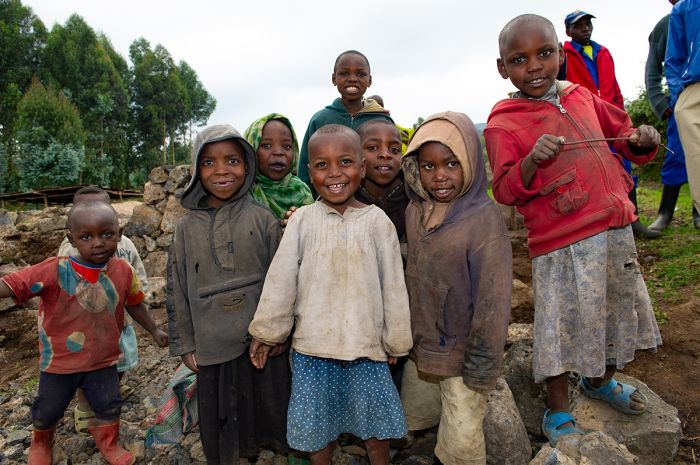
Young villagers greeted us at the end of this trek (Copyright © James Weis)
Other Trekking Considerations
Clothing and Gear
Gorilla trekking involves significant physical exertion and this, combined with unpredictable air temperatures and possible rain and mud, means that being prepared with variable items of clothing is crucial. Dressing in layers is the best plan, as the temperature, even on a clear and warm day, will start out chilly, especially in the high altitudes of the mountains.
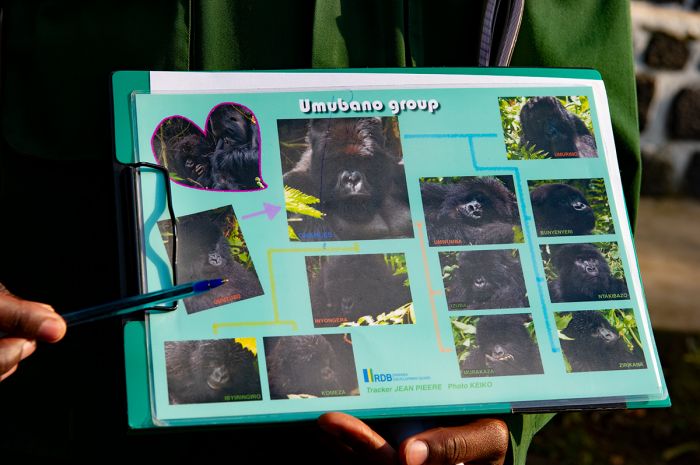
Our guide gives us a briefing on the gorilla family we will visit (Copyright © James Weis)
The following are some recommended items to bring for a gorilla trek:
- Lightweight, frameless, waterproof back/day pack. This pack can be carried by your porter and should be large enough to carry your clothing, food, water, and camera.
- Light, waterproof hiking boots or shoes with treaded soles. Mid-height (over the ankle) hikers are best.
- Hiking socks and gaiters to wear over your pants and shoes.
- Leather or heavy canvas (gardening-style) gloves for moving through the vegetation and especially avoiding any contact with stinging nettles.
- Thin, lightweight, pullover waterproof rain pants to wear over your pants.
- Waterproof shell top with hood.
- Base layer top (sweat-wicking) with a second layer cotton, long sleeve layer over the base.
- Fleece top for the early morning.
- Long pants worn under the rain pants should be the light-weight trekking variety. Some trekkers wear their waterproof pants over long underwear instead of pants.
- Hat to provide rain/sun protection.
- Bottles of water (bring more than you think you'll need).
- Energy bars or other high-energy snacks to keep you fueled.
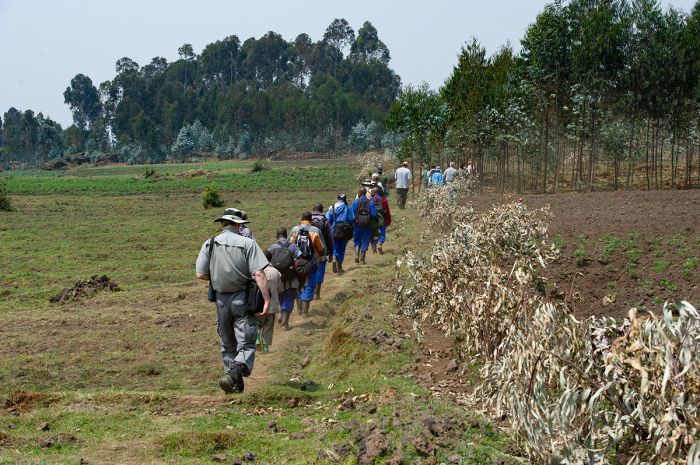
The porters (in blue pants) carry your gear (Copyright © James Weis)
Weather
Gorilla trekking is a year-round activity and even rainy days can be productive for trekking, although mud makes the hiking more difficult and the gorillas may be less active during a rain shower.
The climate in the Virunga Mountains is typically damp, with daytime temperatures averaging 45-65°F (7-18°C).
Dry Season: June-September and January-February are the driest months and offer the best gorilla trekking conditions, but be prepared for afternoon rain at any time. Clear, sunny days are the norm at this time.
Rainy Season: Most rainy days occur from March to mid-May and in October-November.
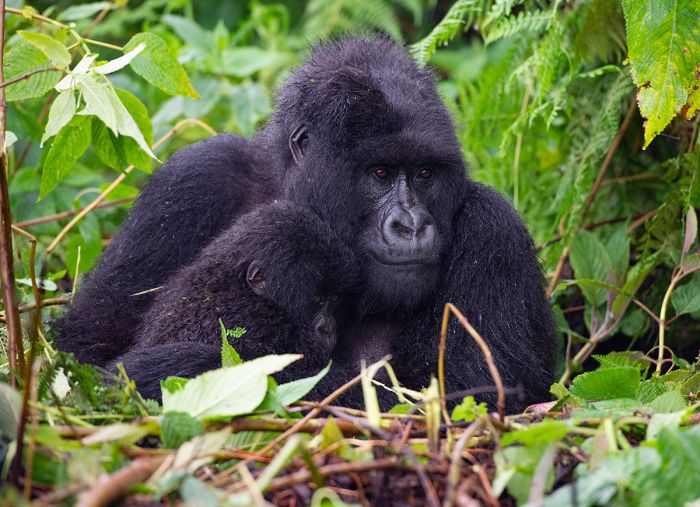
A female and her young huddle during a rain shower (Copyright © James Weis)
Tipping your Guides, Trackers and Porters
The following are our guidelines and you may tip more or less at your discretion:
- Porter US USD 10 per trek.
- Gorilla Trek Guide USD 20 per trek.
- Gorilla Trek Assistant Guide USD 10 per trek.
- Gorilla Trackers USD 5 per tracker per trek (usually 3 or 4 trackers are used to find the gorillas).
- Gorilla Security trekker USD 5 per trek.
Please bear in mind that the porters do not earn any salary, and if you do choose to hire a porter (highly recommended) or two, he or she will depend fully on your tip for income. Guides (1-2 per group), Trackers (2-4 per group) and Security personnel (1-2 per group) do earn salaries.
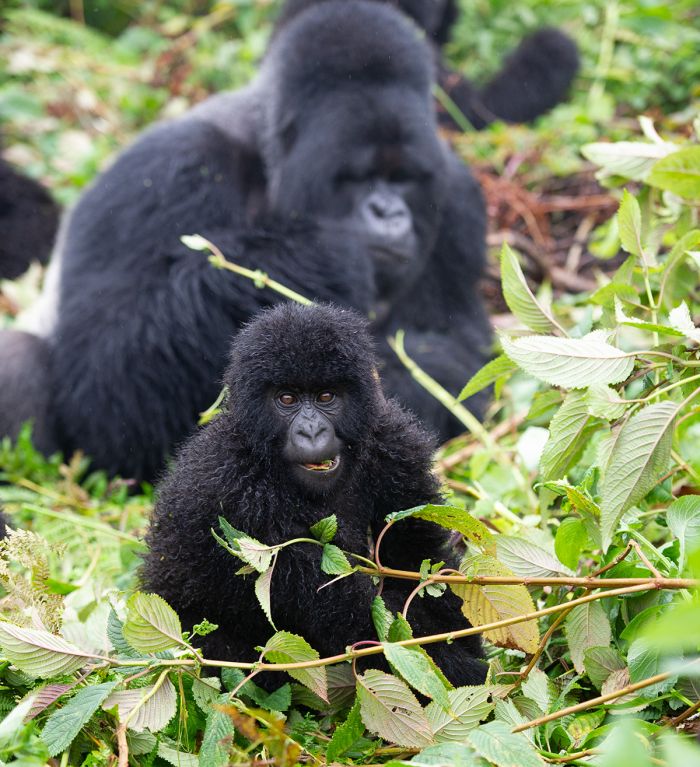
Young gorillas are curious, like human children (Copyright © James Weis)
Trekking Regulations and Rules of Conduct
It is important that all gorilla trekking participants familiarize themselves with the following regulations and rules of conduct:
- Follow the instructions of your guide. He or she is in contact with the gorillas on a regular basis and understands them well. Always remain in a quiet, compact group behind the guide, who will attempt to position you in such a way that the dominant male of the group can see you at all times.
- If the dominant male gorilla (usually a silverback) approaches very closely or if he charges, it is very important that you do not move backwards. Remain exactly where you are, look downward, and adopt a submissive, crouched posture. Do not make any sudden moves or loud noises in the presence of the gorillas.
- If a young gorilla approaches, do not make any move to touch or engage with it. Your guide, in certain instances, may take steps to discourage a youngster from touching you, as this could create a threatening situation with the dominant male.
- Do not use a flash when photographing the gorillas.
- Only visitors in good health will be permitted to track gorillas, as gorillas are susceptible to common colds and other respiratory diseases or viruses transmitted by humans. All visitors should be physically fit and capable of enduring a walk of several hours in difficult terrain (as described above).
- Each gorilla family may be visited only once each day by a maximum of eight trekkers for a maximum duration of one hour. Due to the very limited number of persons allowed to visit the gorillas each day, it is not possible to do gorilla tracking on a private basis.
- Smoking, eating, and/or drinking is not permitted during the one-hour gorilla visit.
- It is prohibited to destroy any vegetation unnecessarily in the national park. The flora and fauna are strictly protected. All visitors must carry their own litter with them out of the park, leaving nothing behind.
- Children under the age of fifteen (15) cannot participate in gorilla tracking.
- Trekkers should be in good physical condition and be physically and mentally prepared to walk long distances over rough terrain if that is where the search for gorillas takes them.
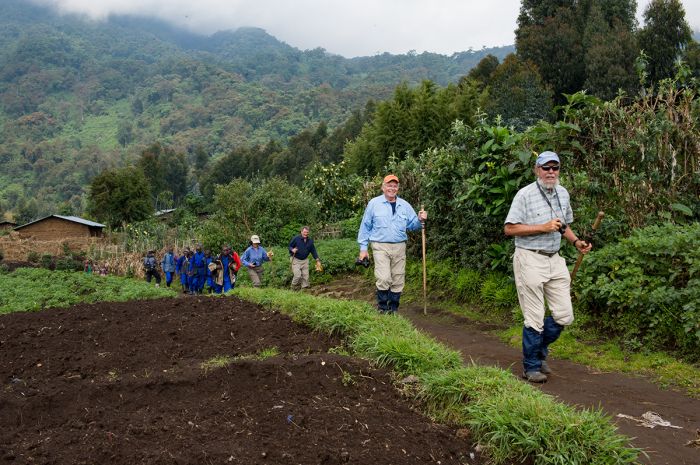
Trekkers climbing at the start of their trek (Copyright © James Weis)
Note of Disclaimer
Eyes on Africa/Eyes on Adventure (EOA) does not control the administration nor play any part in the operation of Rwanda's national parks or reserves. These areas are the total responsibility of local authorities. If the local staff observes situations that merit improvement, they will request that park authorities make changes, but these authorities are under no obligation to do so.
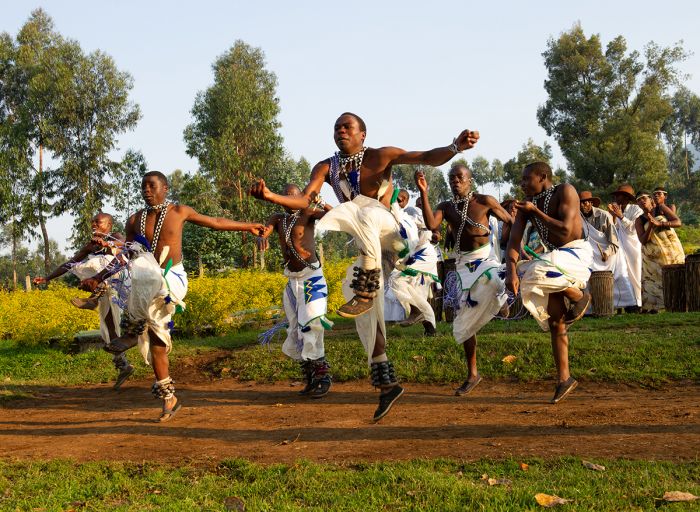
Traditional dance group entertain trekkers at Park HQ (Copyright © James Weis)
While EOA and its local operators have cultivated an excellent relationship with the national park authorities and they are always eager to help us look after our clients, it is they who operate the actual gorilla tracking excursions, not EOA, nor its local operators. It should also be noted that EOA and its local operators do not employ any of the local guides, gorilla trackers nor porters, and therefore, EOA cannot accept responsibility for the manner in which they conduct themselves.
Travelers should keep in mind that the gorilla guides and trackers are local, native-born people who have spent a lot of time in the forest with the gorilla families and that they probably have very good reasons to do things a certain way.
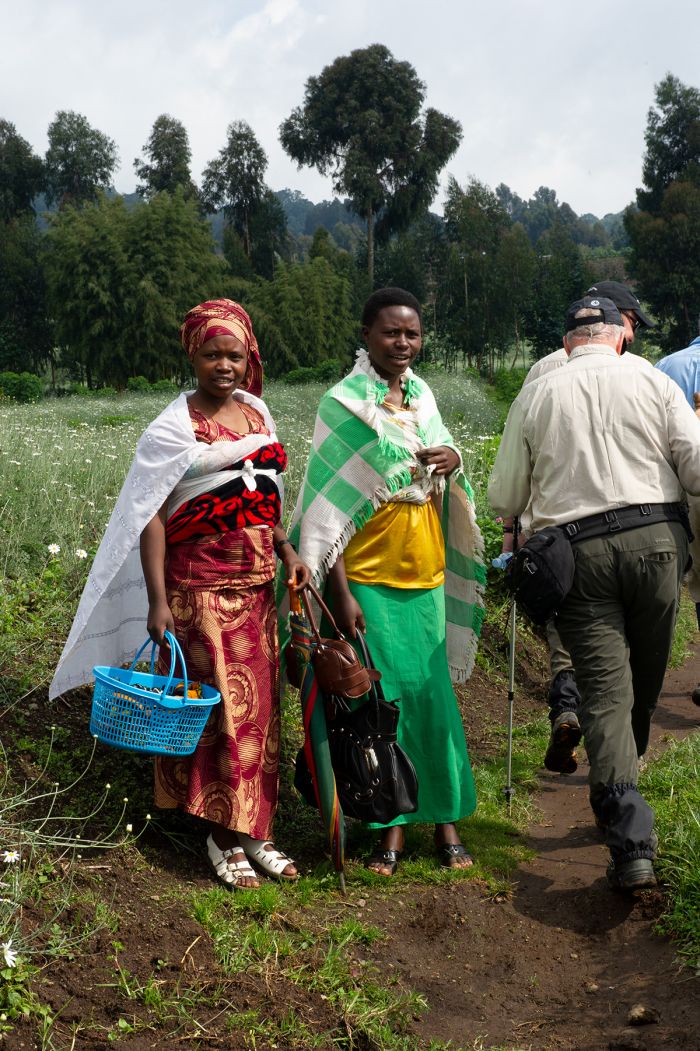
Trekkers pass through farmland en route to the forest (Copyright © James Weis)
Virunga Mountains
The Virunga Mountains are comprised of a chain of volcanoes in and along the borders between Rwanda, the Democratic Republic of the Congo (DRC), and Uganda. This range forms a portion of the Albertine Rift Mountains. The Virunga Mountains are the result of tectonic movements that are slowly separating the eastern side of Africa from the continent.
The name "Virunga" is derived from the Kinyarwanda word "ibirunga", which means "volcanoes".
The Virungas are comprised of eight major volcanoes, six of which are dormant, with only Mount Nyiragongo and Mount Nyamuragira, both in the DRC, still active. Nyamuragira's latest eruptions were in 2010 and 2011. Nyiragongo's last eruption was in 2002 and it destroyed much of the DRC city of Goma on the Lake Kiva shore, leaving thousands of people homeless.
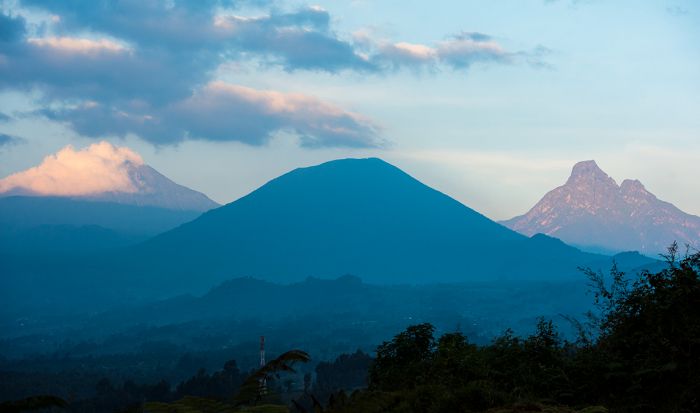
Mount Mikeno (in DRC), Bisoke, and Sabyinyo (L-R) (Copyright © James Weis)
Below is a list of the mountains in the Virungas (listed from highest to lowest):
Mountain Name; Country Location; (Height)
- Mount Karisimbi; Rwanda/DRC; (14 787ft / 4 507m)
- Mount Mikeno; DRC; (14 557ft / 4 437m)
- Mount Muhabura; Rwanda/Uganda; (13 540ft / 4 127m)
- Mount Bisoke; Rwanda/DRC; (12 175ft / 3 711m)
- Mount Sabyinyo; Rwanda/Uganda/DRC; (12 037ft / 3 669m)
- Mount Gahinga; Rwanda/Uganda; (11 398ft / 3 474m)
- Mount Nyiragongo; DRC; (11 380ft / 3 469m)
- Mount Nyamuragira; DRC; (10 033ft / 3 058m)
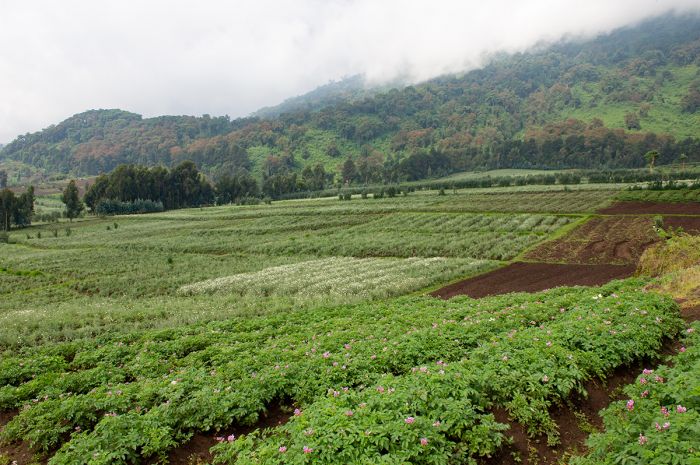
Potatos and pyrethrum are grown in the foothills (Copyright © James Weis)
Sabyinyo and Mikeno are the oldest of the Virunga volcanoes, dating back to the early Pleistocene period, which began around 2.6 million years ago and lasted until only 11 300 years ago.. The craters of both of these mountains have collapsed and eroded.
Karisimbi, Gahinga, Muhabura, and Bisoke all formed between 900 000 and 130 000 years ago, all except Karisimbi having a crater at the summit. Muhabura's crater contains a small lake today.
Nyiragongo and Nyamuragira formed no more than 20 000 years ago at the western end of the chain, both having large craters. Nyiragongo's crater spans three-quarters of a mile (1.2 kms) across and is currently filled again with liquid lava.
The Virunga Mountains are protected by three national parks covering a total of 3 127 sq miles (8 098 sq kms):
- Volcanoes National Park (Parc national des Volcans) in Rwanda: 62 sq miles (160 sq kms)
- Virunga National Park (Parc national des Virunga) in DRC: 3 050 sq miles (7 900 sq kms)
- Mgahinga Gorilla National Park in Uganda: 15 sq miles (38 sq kms)
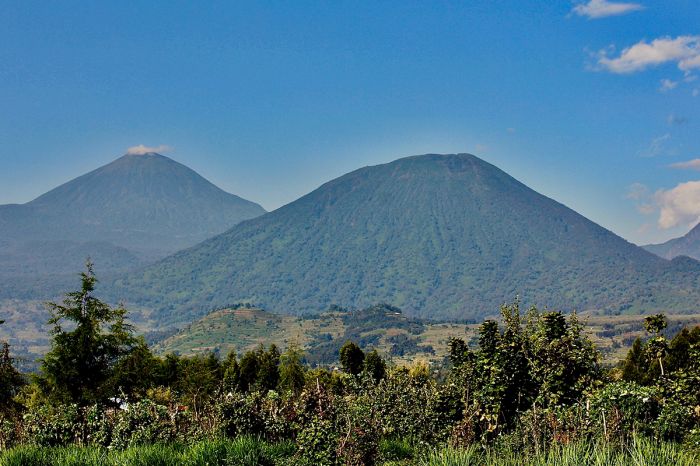
Mount Bisoke in the foreground and Mikeno (in the DRC) in the distance
History
Volcanoes National Park was given its first protection by the Belgian Colonial government in 1925. Four years later in 1929, the Rwandan portion of the volcanoes region was incorporated into Albert National Park, which extended into Uganda and the Congo.
When the Congo and Rwanda were granted independence from Belgium (in 1960 and 1962, respectively), Albert National Park was divided into two separate, but contiguous national parks: Volcanoes National Park in Rwanda and Virunga National Park in the Congo (which was renamed Democratic Republic of the Congo-DRC).
Gorilla trekking first began in Rwanda in 1979, albeit on a very small scale. In the 1980s, the work of Dian Fossey helped Rwanda's mountain gorillas gain international recognition, which led to the hugely popular gorilla tourism that is ongoing today.
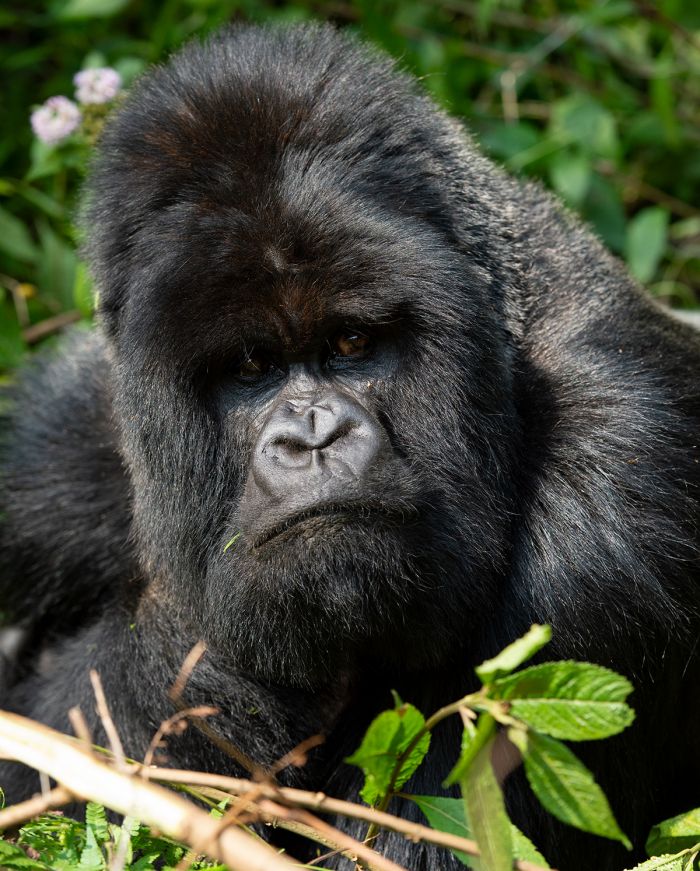
An adult male mountain gorilla in Volcanoes NP (Copyright © James Weis)
National Parks
Albert National Park
Following the discovery of mountain gorillas in the Virunga Mountains in the early 1900s, hunting and live capture began to threaten the gorilla population. In 1925, the Belgian colonial government, which administered the land that includes present-day Rwanda and the DRC, declared Albert National Park to protect the region's wildlife and a population of hunter-gatherer Batwa pygmies.
At this time, Albert National Park encompassed an area of 190 square miles (500 sq kms) surrounding Mount Karisimbi, Mount Bisoke, and Mount Mikeno. The park was greatly extended in 1929 to a huge size of 3 123 square miles (8 090 sq kms) and included additional land in present-day Rwanda. In later years, the park was reduced slightly to clear space for human settlement and agriculture.
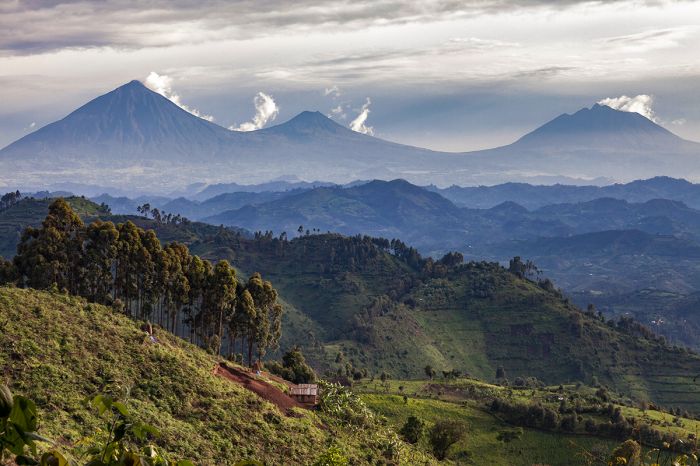
Karisimbi, Bisoke, and Sabyinyo (L-R)
Volcanoes National Park
When Belgium granted independence to the Democratic Republic of the Congo (DRC) in 1960 and Rwanda in 1962, Albert National Park was divided, creating two national parks: one in Rwanda (Volcanoes National Park) and the other in DRC (Virunga National Park).
Between 1969 and 1973, portions of the park in the lower elevations were cleared for agriculture (potatoes and pyrethrum).
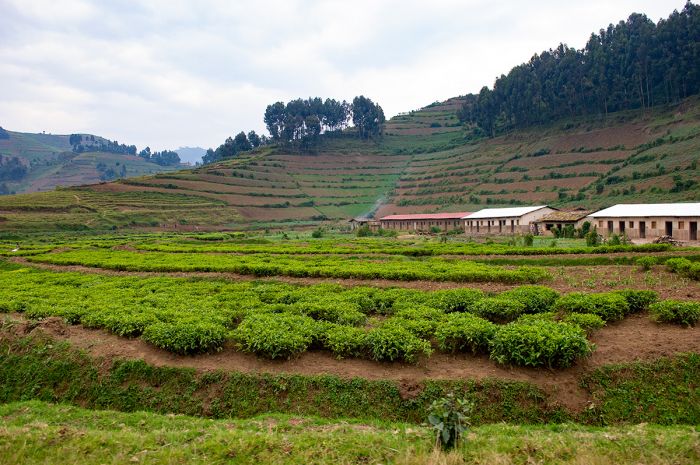
A tea plantation in the foothills of Rwanda's volcanoes (Copyright © James Weis)
Wildlife
Besides the mountain gorillas, which are of course the main attraction here, the park is home to troops of the endangered golden monkey, an Albertine Rift endemic species. One of the golden monkey troops is habituated and can be visited on a dedicated trek. Golden monkeys are rare elsewhere, but can be reliably seen and photographed in Volcanoes National Park.
The park is also home to elephants, which are shy and sometimes seen on forest walks or gorilla treks. The elephants do their best to avoid being seen, but their spoor and dung are seen regularly.
Other animals in the park, most of which are not commonly encountered, include buffalo, spotted hyena, bushbuck, black-fronted duiker, baboon, black-and-white colobus monkey, red-tailed monkey, bush pig, and giant forest hog. Leopard and yellow-backed duiker were once present, but are now thought to be extinct due to deforestation and hunting.
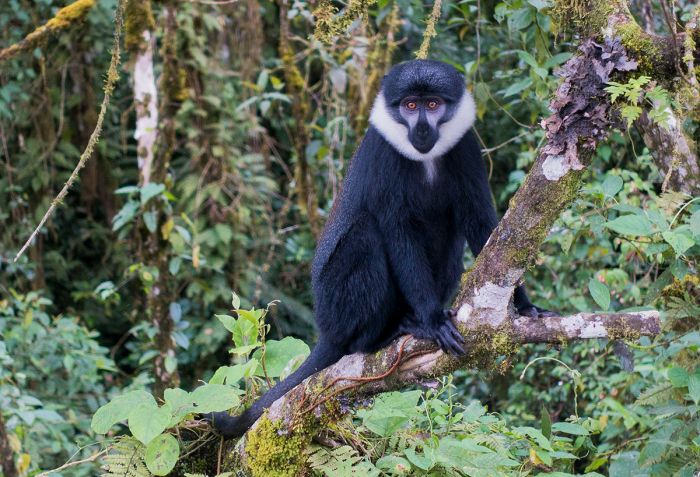
L'Hoest's monkeys are sometimes seen in Volcanoes National Park
Gorilla Research
In 1959, a 26-year-old biologist named George Schaller moved to the Virungas to study its population of mountain gorillas. Very little was known at the time about gorillas living in the wild and his year-long study of the gorillas was ground-breaking.
In 1963, Schaller published a paper titled The Mountain Gorilla: Ecology and Behavior, which gave the world a detailed glimpse into the lives of wild mountain gorillas. Schaller described the gorillas as profoundly intelligent and gentle creatures, which was contrary to widely accepted beliefs at that time.
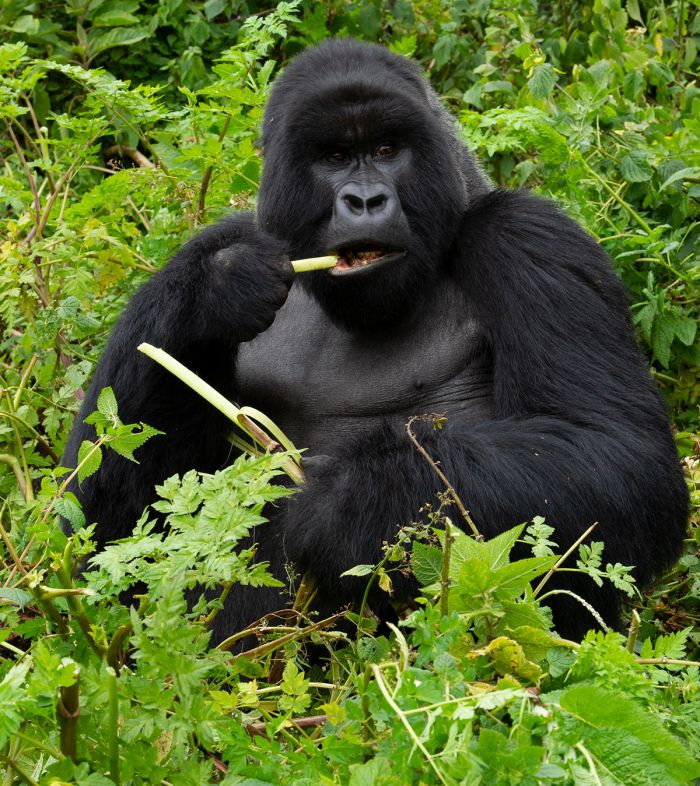
A silverback relishes some "wild celery" (Copyright © James Weis)
Dian Fossey
In 1963, a 31-year-old American named Dian Fossey travelled to Africa on a seven-week tour, borrowing money and using her life savings to do so. While in Kenya, Fossey visited Olduvai Gorge in Tanzania, the archeological site of Louis and Mary Leakey.
The Leakeys were studying early hominid fossils and Fossey was able to meet and spend some time with them. Fossey mentioned her great interest in gorillas and Louis Leakey talked to her about the long-term research on chimpanzees by English primatologist Jane Goodall, whom Leakey had helped establish in Tanzania at Lake Tanganyika.
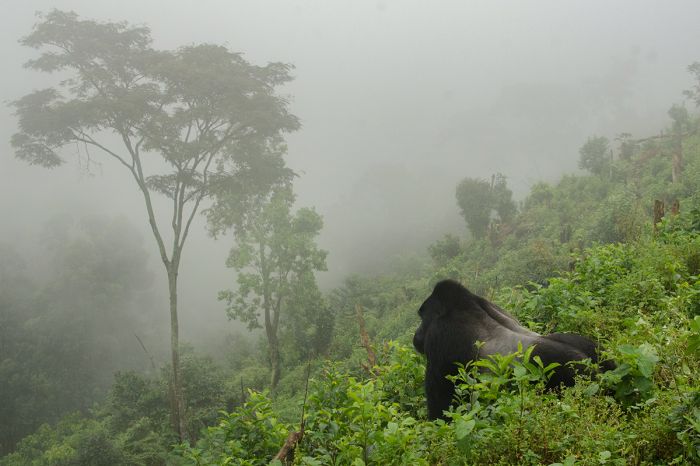
A gorilla in the mist, Volcanoes National Park, Rwanda
Three years later, Fossey was back home in Louisville, Kentucky, when Louis Leakey made an appearance there as part of a nationwide lecture tour. The two reconnected at his lecture, and Leakey suggested that Fossey could undertake a long-term study of the mountain gorillas in the same manner that Jane Goodall had done with the chimpanzees in Tanzania. Leakey offered to set it up and assist with funding and Fossey agreed. During the eight months it took to get her visa, Fossey audited a class on primatology and saved up to help fund her travel.
On her way to the Virungas, Fossey visited Jane Goodall at the Gombe Stream Research Centre at Lake Tanganyika, to observe her methods with the chimps. Fossey's first research camp was established in early 1967 in the DRC, at the same location where Schaller had made his camp seven years prior.
Having had no prior field work experience, she made progress by mimicking the gorillas' sounds, eating the wild celery plant that the gorillas relish, and adopting a submissive behavior in their presence. Unfortunately, Fossey arrived in the DRC during political unrest in the country.
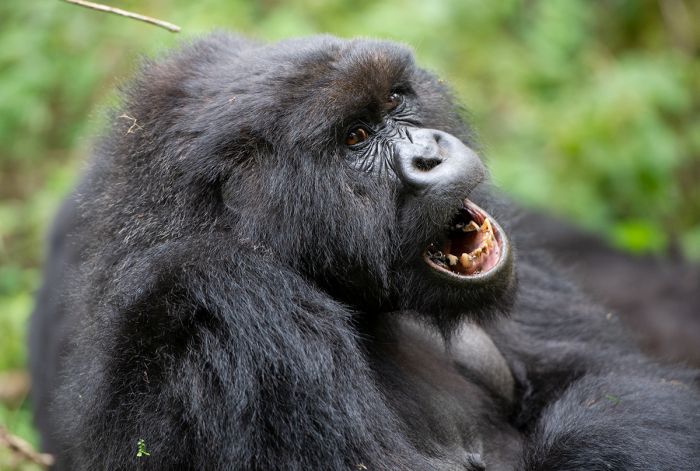
Mountain gorillas are found in Rwanda, Uganda, and DRC (Copyright © James Weis)
Following the DRC's independence from Belgium in 1960, the new country experienced five years of violent unrest and political upheaval, with an estimated 100 000 people killed during what is known as the "Congo Crisis". In November 1965, DRC military leader Joseph-Désiré Mobutu mounted a coup d'état, effectively taking control using military strength and transformed the country into a dictatorship, which laster until he was ousted in 1997 during the "First Congo War".
In July 1967, DRC soldiers arrived at Fossey's camp and detained her and her research team at a military base for two weeks. She was able to escape using bribery and fled to the small town of Kisoro in Uganda. After the ordeal, Fossey decided to resume her gorilla research on the Rwandan side of the border.
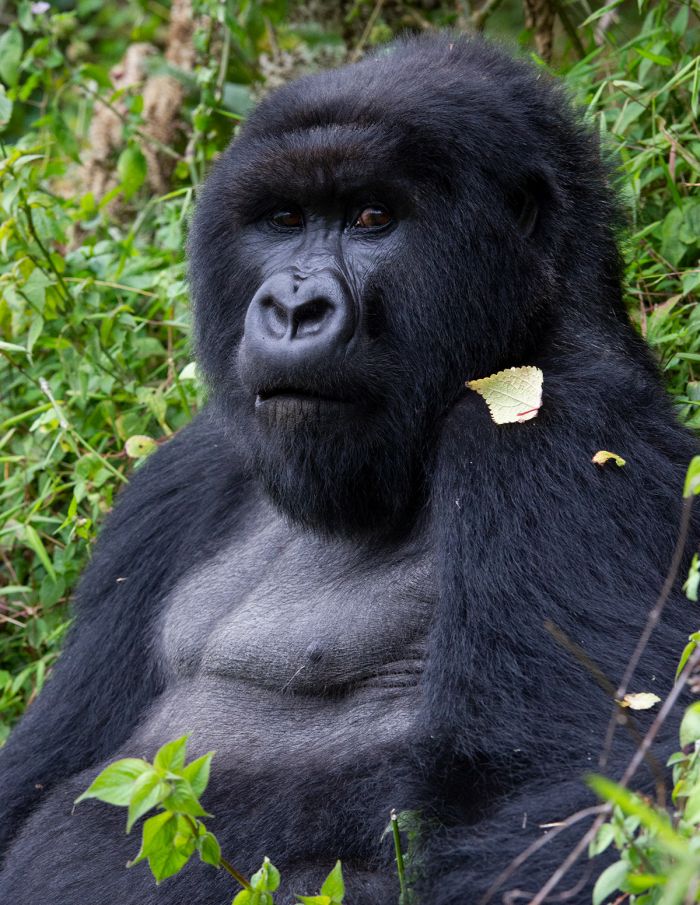
Dian Fossey's initial research was in DRC (Copyright © James Weis)
Karisoke
In September 1967, Fossey founded the Karisoke Research Center in Rwanda's Volcanoes National Park. The camp was located in the "saddle" between Mount Karisimbi and Mount Bisoke and Fossey named it by combining the names of the two mountains. Karisoke was established at 9 800 feet (3 000 meters), with a defined study area covering 10 square miles (25 sq kms).
Fossey's work at the time was primarily funded by the National Geographic Society, and in 1970, she appeared on the cover of National Geographic Magazine, which brought her instant notoriety and raised global attention to the gorillas and her work.
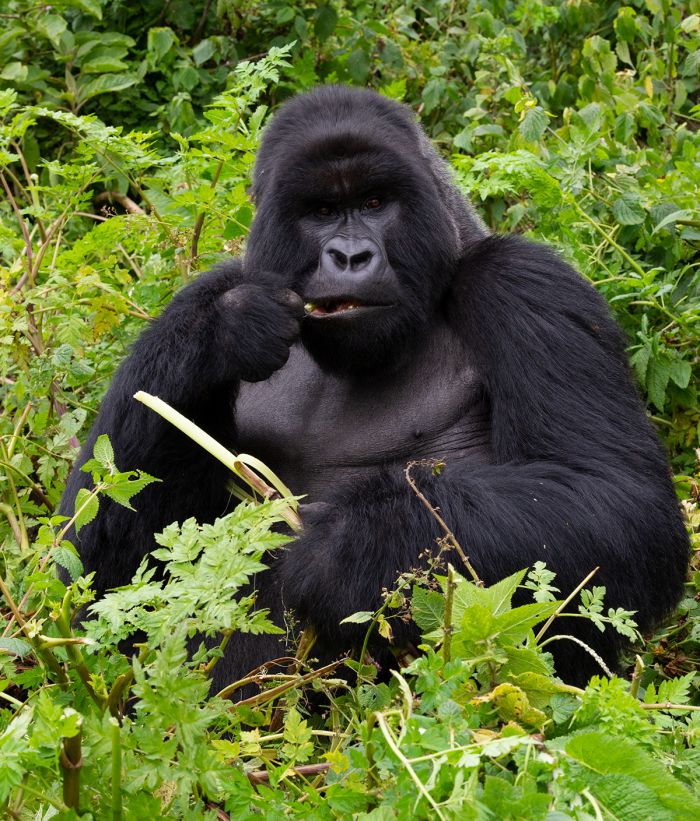
Mountain gorillas consume over different 100 plant species (Copyright © James Weis)
Poaching
Unlike the gorillas on the DRC side, the gorillas in Rwanda had only been exposed to humans as poachers, so it took great effort and time for Fossey to establish their trust. Over time, the gorillas grew accustomed to her presence and eventually accepted her.
Although hunting had been illegal in Volcanoes National Park since 1925, the law was almost never enforced and bribery of park staff, who were poorly paid, made it easy for poachers to capture or kill gorillas. Baby gorillas were often targeted for live capture to send to zoos, but since a gorilla family will fight to the death to protect their young, these captures usually resulted in the deaths of ten or more adult gorillas.
Fossey became a fierce protector of the gorillas in her research area, with her team removing thousands of poachers' bushmeat snares from the forest around Karisoke while operating regular anti-poaching patrols. Although gorillas were being decimated (along with elephants) in the eastern portion of the park, none of the gorillas in Fossey's study groups had become direct victims of poaching as of late 1977.
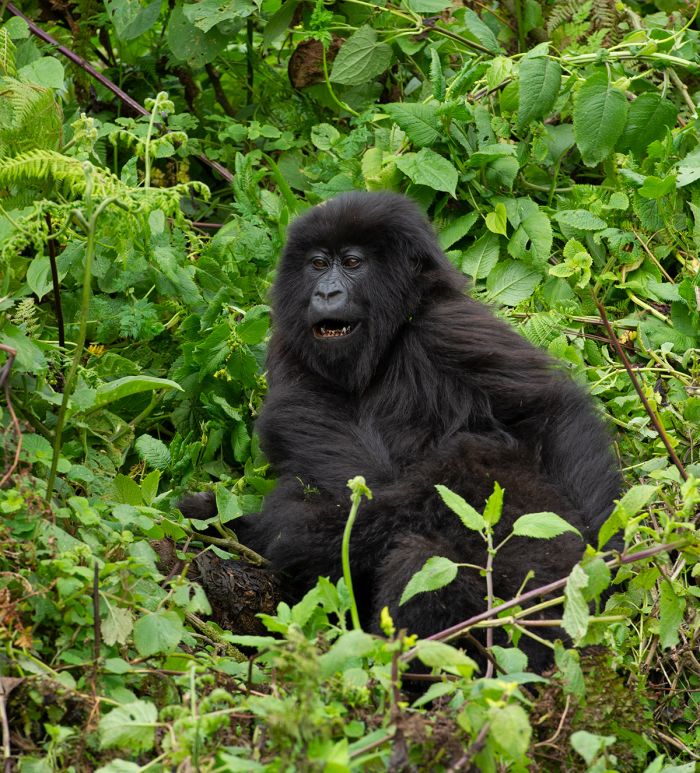
Dian Fossey was fiercely protective of the gorillas (Copyright © James Weis)
Digit
On New Year's Eve 1977, Fossey's most beloved gorilla, Digit, was killed by poachers. Named for his mis-formed finger, she met Digit as a youngster and they formed a special bond, even as he became a large silverback. Digit defended his family from six poachers and their dogs, taking spear wounds and killing one of the dogs, and allowing the rest of his group of thirteen gorillas to escape. Digit was decapitated and his hands removed for use as ashtrays. He was only twelve years old.
After Digit's body was discovered by Fossey's research assistant Ian Redmond, Fossey's team captured one of the poachers, who revealed the names of his accomplices, several of whom were later imprisoned. Fossey was profoundly affected by the loss of Digit, describing it as the "saddest event in all my years of sharing the daily lives of mountain gorilla." The event sent Fossey into a serious depression. In the months following Digit's death, other gorillas in her study group also fell prey to poachers.
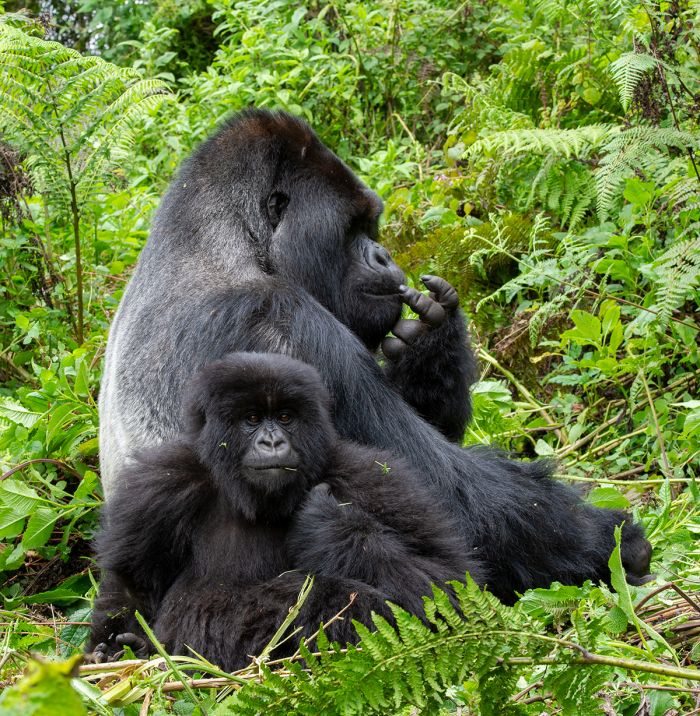
A young gorilla sits with his father (Copyright © James Weis)
Anti-Poaching
After the death of Digit and others in her gorilla study groups, Fossey became more focused on anti-poaching and devoted less of her time on research and publishing. She initiated a more militaristic approach to protecting the gorillas and began employing more direct tactics against the poachers, including feigning witchcraft by wearing face-masks and using cheap store-bought magic tricks to frighten them. She reportedly captured suspected poachers and used various forms of intimidation to threaten them.
By the late 1970s, Fossey was widely recognized as the world's foremost authority on mountain gorilla physiology and behavior. In 1980, Fossey returned to the USA and spent two years as visiting Professor of Neurobiology and Behavior at Cornell University. In 1983, Fossey released her best-selling book, Gorillas in the Mist, which documents her time with and study of the gorillas. She returned to Rwanda in 1983 to continue her work with and efforts to protect the gorillas.
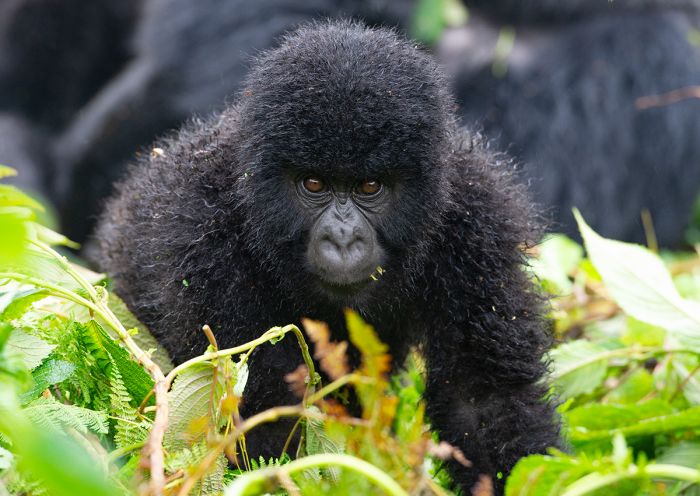
Gorilla tourism has saved the mountain gorilla from extinction (Copyright © James Weis)
Death
In the early morning hours of 27 December, 1985, Dian Fossey was discovered murdered in her cabin at Karisoke. She had been killed by a machete and her cabin ransacked. Fossey's valuables were not stolen, including her passport, a 9mm handgun, and thousands of US dollars in cash.
Although officially unsolved, her murder is widely considered to be the work of one of the poachers whom she had encountered while trying to protect the gorillas. The last entry in her diary read: "When you realize the value of all life, you dwell less on what is past and concentrate more on the preservation of the future."
Fossey was buried at Karisoke, at a graveyard site she had prepared for some of her study group gorillas that were killed by poachers. Her grave is positioned next to Digit's.
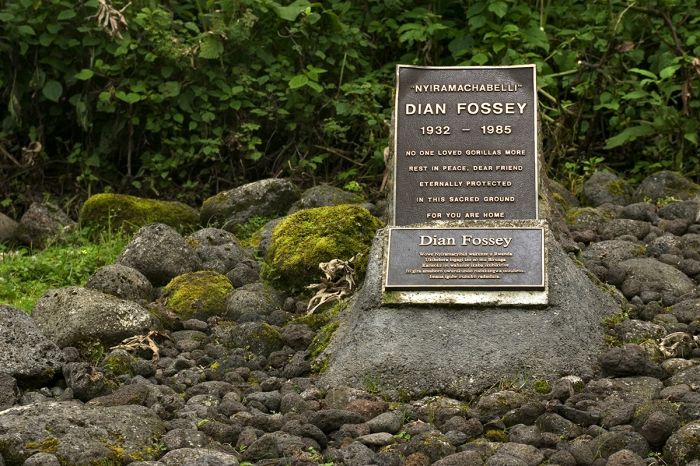
Dian Fossey's grave site near Karisoke
In 1988, three years after her death, Fossey's book Gorillas in the Mist was released as a major motion picture, filmed on location in Volcanoes National Park, with Sigourney Weaver in the starring role. The film was a worldwide success, was nominated for five Academy Awards, and created global interest in the mountain gorillas, leading to a surge in ecotourism for the Virungas.
During her 18 years in Rwanda, Fossey's field work with the gorillas revealed numerous insights into the gorillas' social structure, vocalizations, diet, reproduction, and much more.
Furthermore, it is in large part due to Fossey's dogged determination to halt gorilla poaching that there were still mountain gorillas still alive to be protected. After her death, gorilla trekking, especially in Rwanda, really took off, bringing an almost immediate halt to poaching on the Rwandan side of the border.
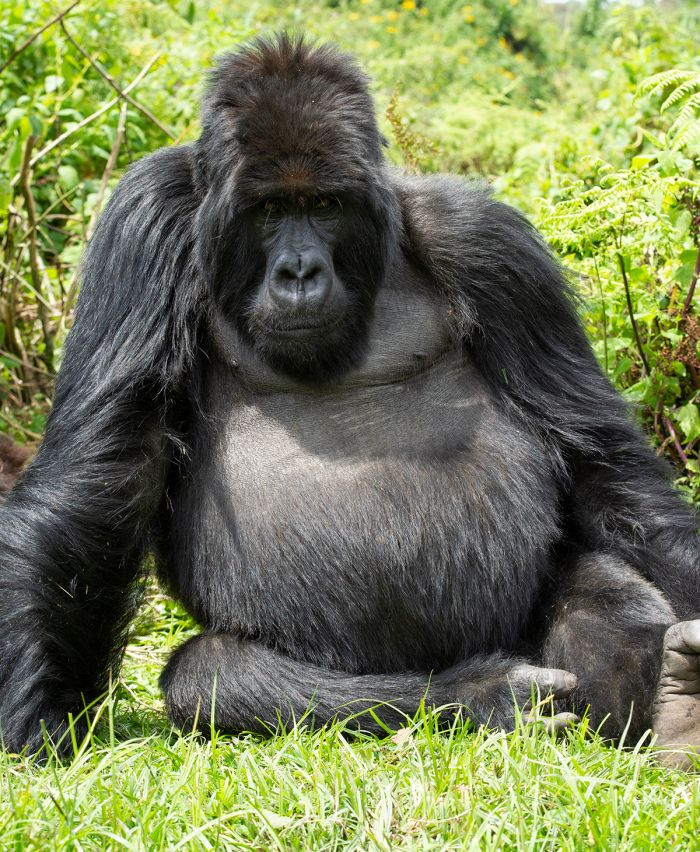
Dian Fossey spent 18 years with the gorillas (Copyright © James Weis)
Gorilla Conservation & Tourism
Early Gorilla Tourism
Gorilla trekking had been a small-scale tourism activity in Volcanoes National Park since 1979, but after the death of Dian Fossey in 1985 and the release of the major motion picture Gorillas in the Mist in 1988, gorilla tourism took off in Rwanda.
The growing worldwide interest in seeing and saving the mountain gorilla created a significant revenue source for Rwanda and there was a new national pride developing around the mountain gorilla.
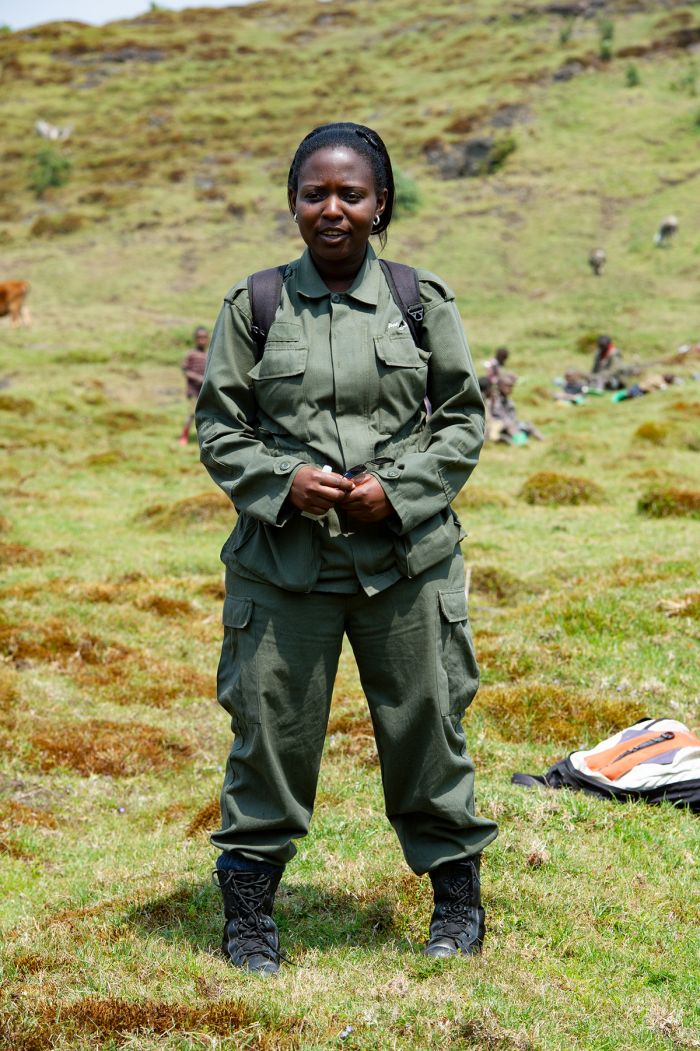
A Volcanoes NP gorilla trekking guide (Copyright © James Weis)
The Rwandan government quickly realized that protecting the mountain gorillas as a renewable resource was crucial for its young tourism industry and it officially recognized the mountain gorilla as its leading source of tourism revenue. A count of gorillas in 1989 reflected that the population in Rwanda was increasing and numbered 325 individuals.
Gorilla trekking continued its popularity, but in late 1990, the Rwandan Civil War broke out between the country's two ethnic groups, the Hutus and the Tutsis. The conflict continued to escalate and in 1992, the Volcanoes NP Headquarters was attacked by rebels and two park employees were killed. The Karisoke Research Centre had to be evacuated, resulting in the termination of all gorilla tourism.
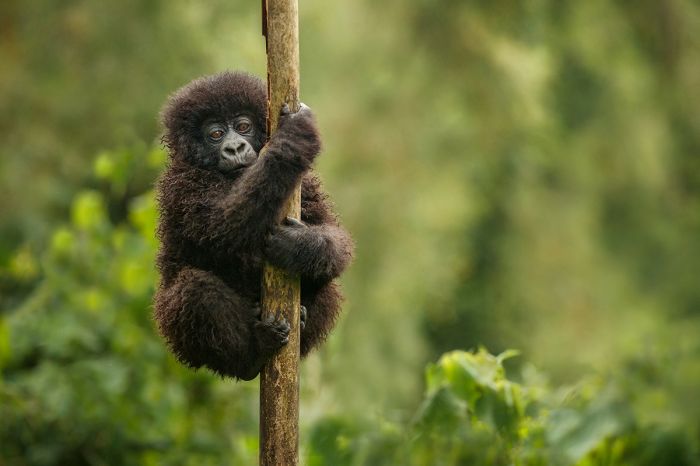
Gorilla-based tourism is crucially important in Rwanda
Volcanoes National Park was officially closed until June 1993, but when the Rwandan Genocide occurred in April 1994, the park was again closed, this time until 1999, when it was deemed to be safe and re-opened for tourism.
Across the border in the DRC, there was continued political and social instability, and in August 1998, the Second Congo War broke out (just a year after the First Congo War ended), officially lasting until July 2003. Numerous gorillas were killed in Virunga National Park during the years of these civil wars. Virunga NP was closed for tourism until its re-opening in 2005.
Note: Visit our Rwanda Country pages for a detailed history of the Rwandan Civil War and Genocide.
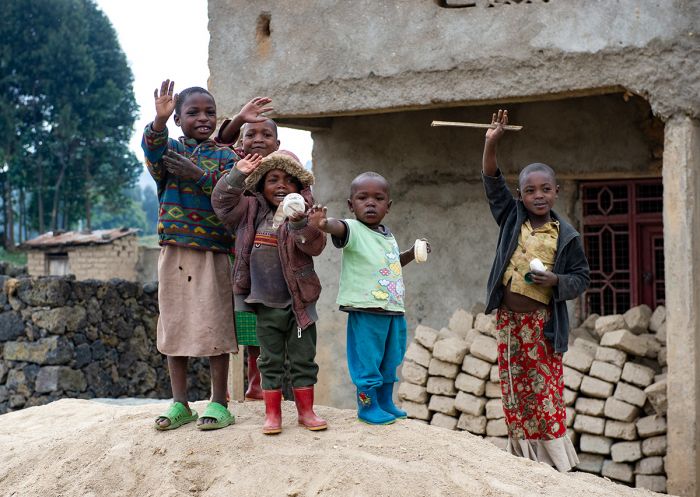
Gorilla tourism benefits Rwandans living nearby (Copyright © James Weis)
Current Gorilla Tourism
Mountain gorilla numbers in the Virungas are rebounding from the days of rampant poaching and civil unrest in the region. Some thirty years ago (~1990), there were an estimated 240 mountain gorillas remaining in the Virunga Mountains (with an unknown number in Uganda's Bwindi NP). A 2016 census indicated that the Virunga population increased from 480 in 2010 to 604 in 2016.
The most recent census, completed in 2019, and performed by the Greater Virunga Transboundary Collaboration, a coalition of governments, non-profits and conservationists, showed that the total population in the region, which includes Uganda’s Bwindi Impenetrable National Park, is 1 063 gorillas.
Given that during the 1970s-1980s, when Dian Fossey was living and working with the gorillas in Rwanda, it was thought probable that mountain gorillas would become extinct by the year 2000, their current status is good news shows that gorilla tourism is indeed working to increase gorilla numbers.
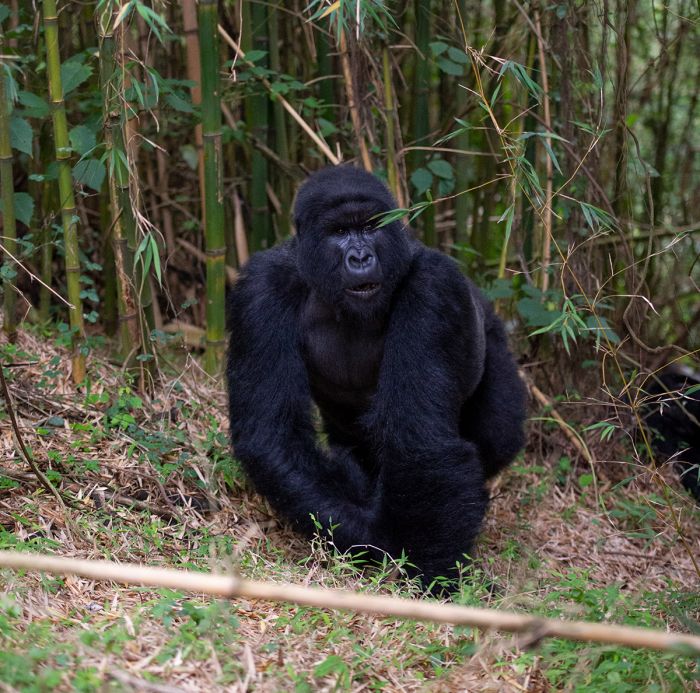
A strong young male emerges from the bamboo (Copyright © James Weis)
Despite recent successes, mountain gorillas are still critically endangered due to human encroachment into their habitat, snares set for other animals, and potential disease. With a total population of around 1 000 mountain gorillas remaining, separated in two distinct populations (Virungas with around 600 and Bwindi with around 400), they are one of the world's most endangered animals.
Revenue from the gorilla permits is reinvested into Rwanda's national parks and a portion is given to the local communities living around the park. Additionally, local Rwandans are employed as trekking guides and porters, researchers, veterinarians, and employees in the nearby lodges and camps. New lodges have been built in recent years, with some effectively re-converting agricultural land around their lodge back into gorilla habitat.
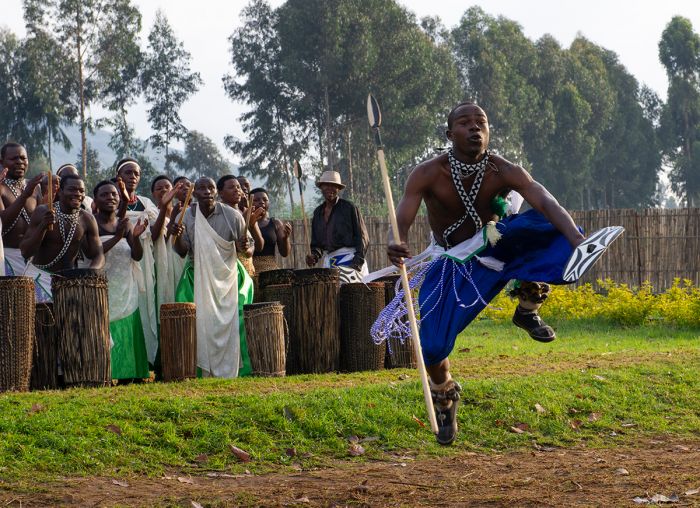
Local people benefit from gorilla tourism (Copyright © James Weis)
Kwita Izina
Meaning "to give a name" in the Kinyarwanda language, Kwita Izina is a traditional ceremony that takes place when a new baby is born into a Rwandan family. The baby is carried out to show to the village, whereafter the village children suggest names for the infant. The parents select one of the suggested names for their child. This cultural tradition helps to vest the entire village in all of its children.
Since the onset of gorilla eco-tourism in Rwanda, this ancient custom has been applied to the country's mountain gorillas. Each year in September, Rwanda hosts a celebration to name the new babies born to mountain gorilla families in Volcanoes National Park during the preceding twelve months.
The week-long program includes a gorilla conference, forums on sustainable tourism and wildlife conservation, and the actual naming ceremony. The event attracts thousands of visitors, including celebrities, dignitaries, international guests and locals. Festivities include traditional musical performances, dancing, art shows, parties, and more. The Kwita Izina program helps to raise awareness and funding for the continued conservation of mountain gorillas.
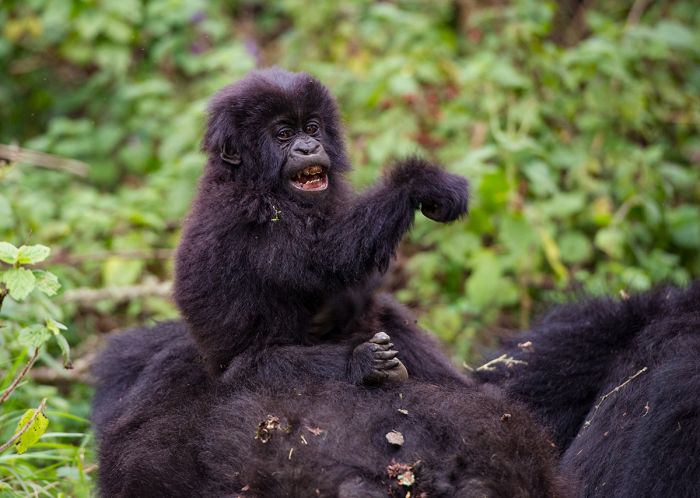
New gorilla babies are named at the Kwita Izina ceremony (Copyright © James Weis)
Golden Monkeys
Visiting a golden monkey troop is the other main wildlife-related activity on offer for visitors to region. The golden monkey (Cercopithecus kandti), like the mountain gorilla, is an endangered species restricted in range to the Albertine Rift Mountains of Rwanda, Uganda, and the DRC. The estimated remaining population of golden monkeys is 2 500-3 500.
Like gorilla trekking, observing the golden monkeys requires the purchase of a trekking permit (USD 100 per permit), meeting at the Park HQ at 7:00am, and then driving to the trailhead. Pre-booking is less crucial than it is for gorilla trekking, but purchasing permits before travel is advisable.
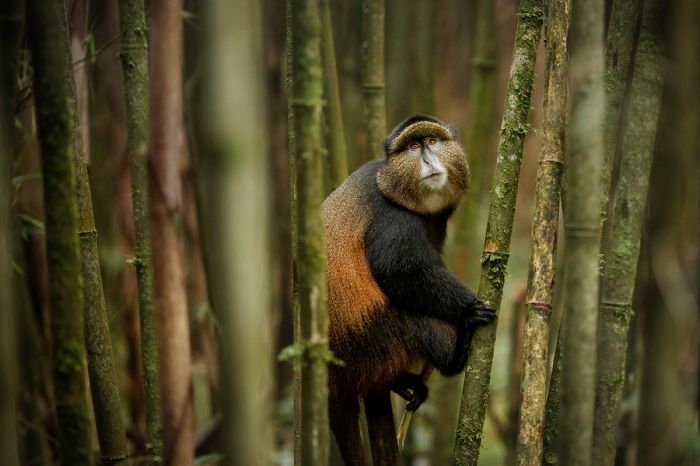
A golden monkey in the bamboo forest, Volcanoes National Park, Rwanda
There are two habituated troops of golden monkeys, the largest and most often visited troop having between 80 and 100 monkeys. This troop is most often observed in the lower elevations of Mount Sabyinyo and the trailhead is only a 15-minute drive from the Park HQ. When the monkeys are in the bamboo forest, which is common, the treks are usually less than one hour of walking and the terrain is easier than on a typical gorilla trek. Of course, the monkeys do move to higher elevations and their location is never guaranteed.
Golden monkeys were originally classified as a subspecies/race of the blue monkey (Cercopithecus mitis), but are now given species status. The golden monkey is aptly named for its bright-orange or golden fur, which covers its back, cheeks, and tail, contrasting with jet-black fur covering its head, shoulders, and legs. Males weigh between 10-15 pounds (4-7 kgs) and females are slightly smaller. Their eyes are amber in color.
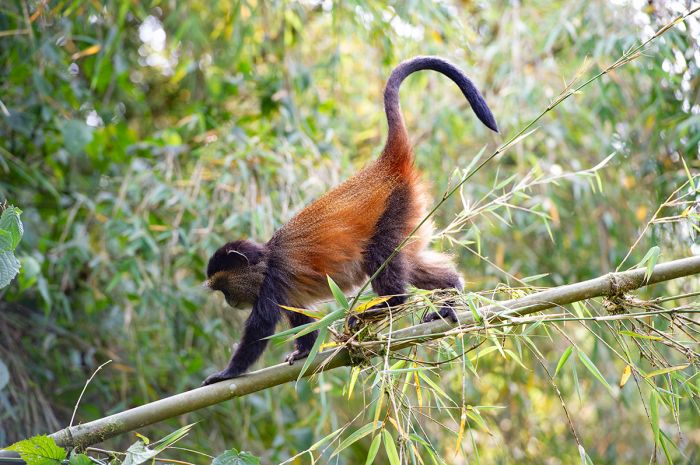
A golden monkey trek provides another primate activity (Copyright © James Weis)
Golden monkeys are social primates, living in large troops of 30-80 individuals, with one alpha male that is dominant over the entire group. They are mostly herbivorous, feeding on a variety of plant species, but also on grubs, insect larvae, and other invertebrates. They have a strong preference for bamboo shoots and various fruits.
Viewing the monkeys and getting good photos is a bit more challenging compared to the gorillas, as the monkeys are invariably found overhead feeding in the bamboo, The monkeys are small, nimble and move quickly, jumping from branch to branch. Nonetheless, golden monkey trekking is a worthwhile activity and the monkeys are extremely relaxed, hardly taking notice of the trekkers and guides on the ground.
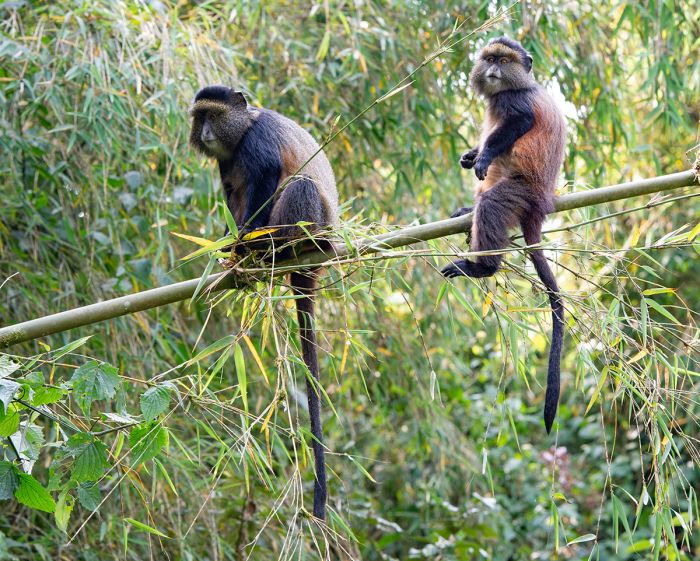
Golden monkeys are often seen in the bamboo forest (Copyright © James Weis)
Other Hiking Options
There are several other non-primate-based hikes available to visitors, some of which are only for the very intrepid. Some are day hikes, while the ascent of Mount Karisimbi is a two-day trek requiring an overnight of camping.
Dian Fossey's Grave
The day-hike to visit the grave of Dian Fossey and gorilla cemetery at her former Karisoke Research Centre is a popular trek. The adventure starts with check-in at the Park HQ at 7:00am, a 30-minute drive to the trailhead, and a hike lasting 1.5 to 3 hours to the site, depending on your speed. The descent takes 1-2 hours. The ruins of Fossey's cabin and other interesting landmarks can be seen in her old camp.
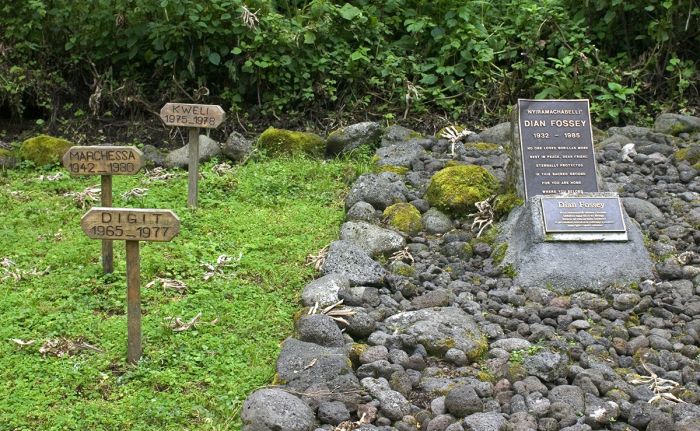
Dian Fossey's grave at Karisoke
Mount Bisoke
The day hike to the summit and crater lake atop Mount Bisoke is a demanding trek. The climb begins from a car park at an altitude of 8 200 feet (2 500 m) and ends at the peak's altitude of 12 175 feet (3 711 m). The climb is quite challenging due to the steepness and the usually muddy conditions of the trail.
This is a hike that should only be attempted during the dry months, as during the rainy season, the path will be treacherous and the crater lake is more likely to be obscured by clouds. The combined hiking time is 6-8 hours, which is highly dependent on your level of fitness. Time spent at the crater lake is usually 30 minutes before descending.
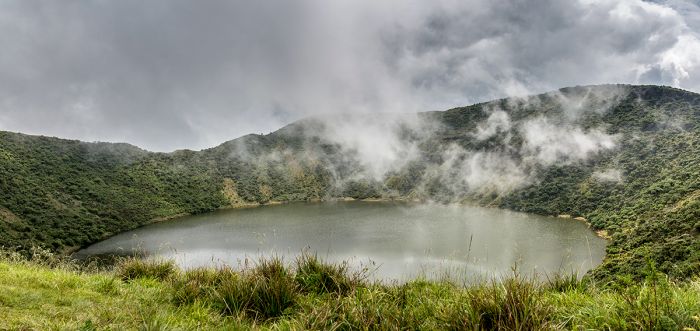
The crater lake atop Mount Bisoke
Mount Karisimbi
The most challenging of the treks is the 2-day trek to the summit of Mount Karisimbi. This hike should only be attempted by serious hikers, as it is very demanding and requires an overnight in a tent in freezing temperatures. That said, the Karisimbi climb offers an incredible experience, with the trail passing through a myriad of vegetation zones, including the surreal upper elevation sub-alpine and Afro-alpine zones.
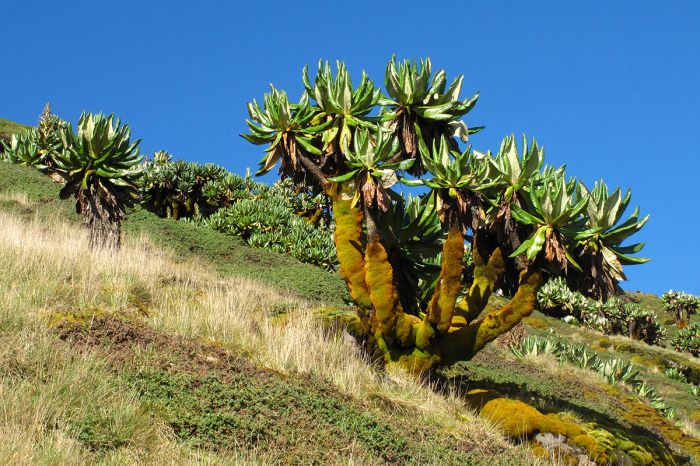
Giant senecio plants growing on upper-elevation Mount Karisimbi
Where to Base
There are four options when selecting a locale for your base when visiting the volcanoes. Gorilla trekking check-in time is 7:00am, so your choice of location will determine your wake-up time.
Kinigi
Staying in the vicinity of the Volcanoes National Park Headquarters allows for a quick drive of 10-15 minutes to the HQ. There is a good selection of mid and high-end lodges in the Kinigi area.
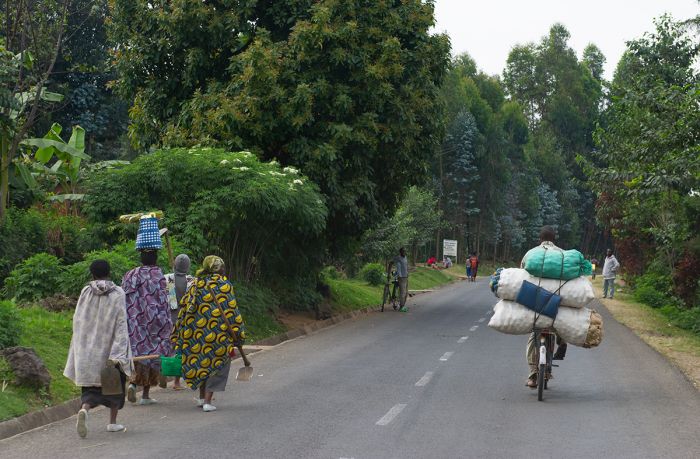
Local Rwandans on a road in Kinigi (Copyright © James Weis)
Lake Burera
Virunga Lodge, with its stunning views over Lake Burera and the volcanoes to the west, is one of Rwanda's best lodges. The drive to the Park HQ takes about 40 minutes.
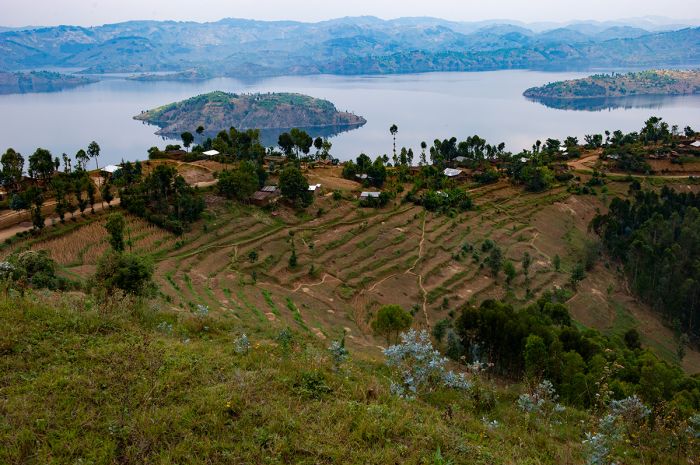
View of Lake Burera (Copyright © James Weis)
Lake Kivu / Gisenyi
Due to its distance from Volcanoes NP's headquarters, Gisenyi is seldom chosen as a gorilla trekking base, but it is still a viable option. Staying here requires a very early wake up, followed by a 1hr-40min drive.
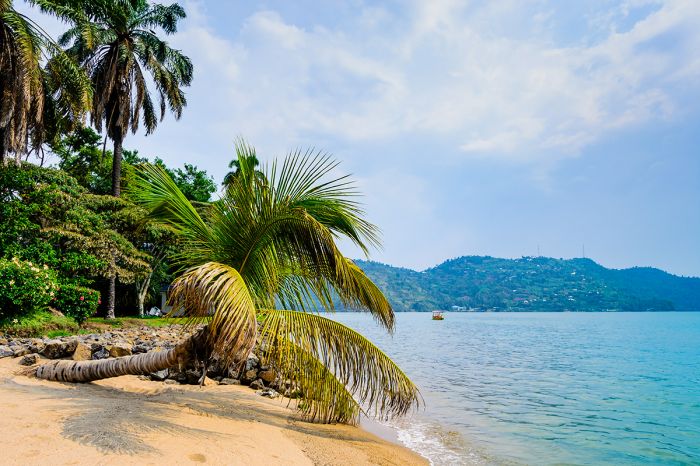
Scenic at Lake Kivu in Gisenyi, Rwanda
Ruhengeri
Visitors on a restricted budget often choose one of Ruhengeri's affordable lodgings. The drive time to Park HQ is around 15 minutes.
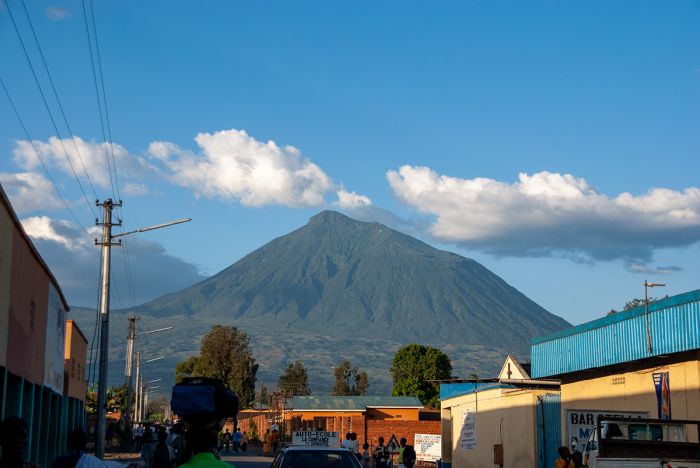
View of Mount Karisimbi from Ruhengeri
Read More...
Mountain Gorillas: Activity, Diet, Discovery, Gorilla Research, Gorilla Tourism, Habitat, Physicality, Reproduction, Society, Taxonomy
Gorilla Trekking: Background, Clothing & Gear, Permits & Pre-Trek, Time with Gorillas, Tipping, Trekking Details, Trekking Rules, Weather
Geography/History: Dian Fossey, Golden Monkeys, History, Kwita Izina, National Parks, Other Hikes, Virunga Mountains, Where to Base, Wildlife
Great Good Fair Poor
- Jan
- Feb
- Mar
- Apr
- May
- Jun
- Jul
- Aug
- Sep
- Oct
- Nov
- Dec
Gorilla Trekking in Rwanda is a year-round activity and although there is a short dry season from June-September, be advised that rain can occur in Rwanda's volcanic mountains at any time of year.
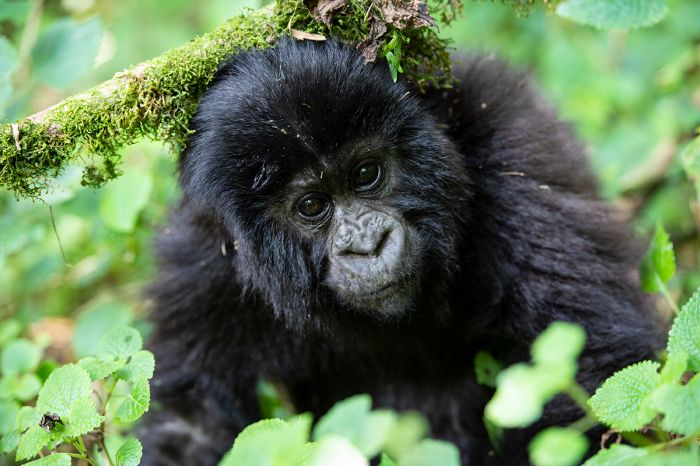
A curious young mountain gorilla (Copyright © James Weis)
CLIMATE
The montane climate in Volcanoes National Park is defined by regular rains throughout most of the year, mist, and chilly air. Air temperatures are fairly static all year in the mountains, with daytime temps averaging 58-63°F (14-17°C) and overnight/early mornings dropping to 40-45°F (4-7°C).
Be advised that temperatures drop as you ascend the mountains while trekking and sudden weather changes, like rain or cloud cover, can impact air temperatures. For this reason, dressing in layers and brining rain gear on every trek is suggested. Please read our Clothing and Gear section on the previous tab for details on what to bring.
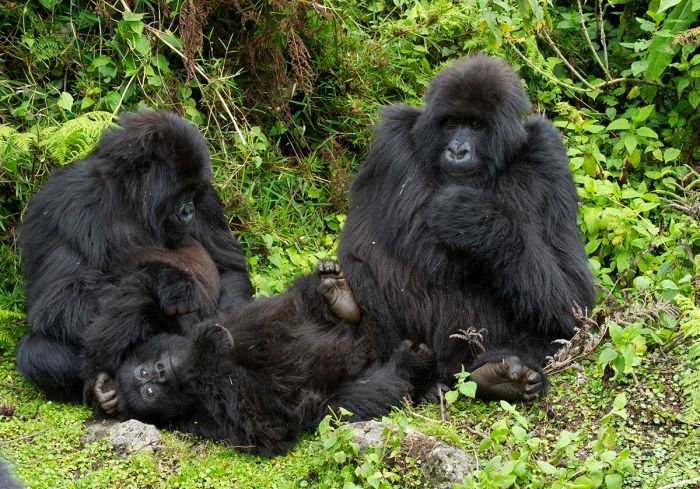
Rain is always a possibility in the mountains (Copyright © James Weis)
GORILLA TREKS
The high season for gorilla trekking is during the drier winter months of June, July, August, and into early September. If you plan to do gorilla treks during this time of year, it is strongly advised to book far in advance and don't forget to purchase your gorilla trekking permits.
For much of the year, rain is common in Volcanoes National Park, but is not usually an all-day event. March through May receive the most rains, with April the wettest month. Recent rainfall will mean the trails will potentially be muddy and slippery in places.
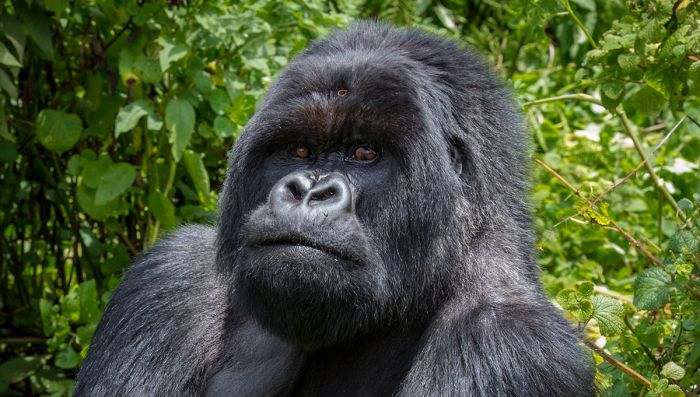
A silverback's stare can be intimidating (Copyright © James Weis)
Rain gear (boots, pullover rain pants, rainproof shell, and hat) should be brought on your trek regardless of the time of year. Be sure to pack rain protection for your camera equipment as well. Please read our Clothing and Gear section on the previous tab for details on what to bring.
If it rains during your gorilla trek, do not be overly concerned, you will still see the gorillas and unless it is a full downpour, the gorillas will still provide a great experience. While the gorillas are generally less active during a steady rainfall, they are used to the rains and carry out their daily activities, rain or shine.
Gorilla trekking outside of the prime, dry months will allow for ease of getting permits and the rates at many of the lodges may also be lower.
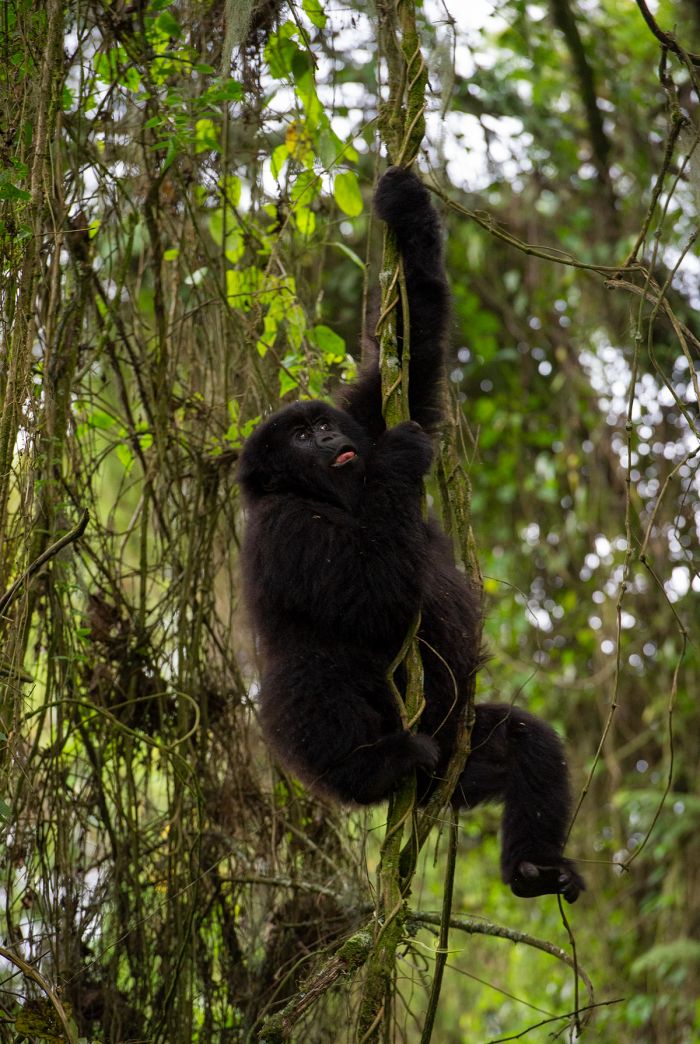
A young mountain gorilla climbs a vine (Copyright © James Weis)
Showing 1–2 of 2 results
Bisate is a high-end lodge situated on the border with Volcanoes National Park. The highlight is gorilla trekking, where small groups of tourists visit a family of wild, semi-habituated mountain gorillas.…




